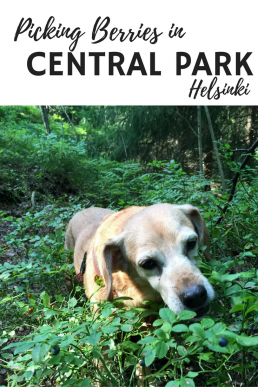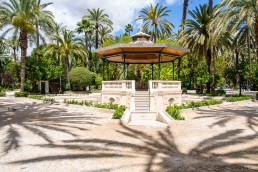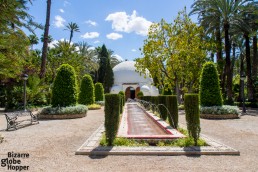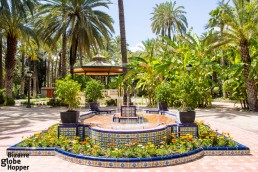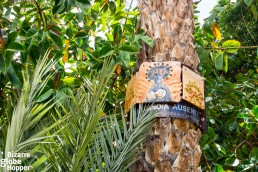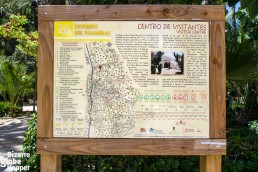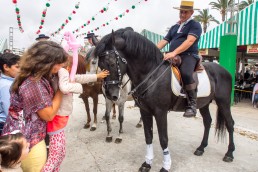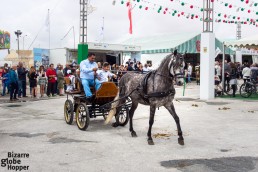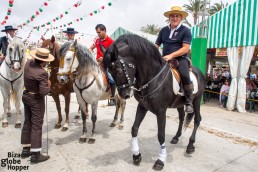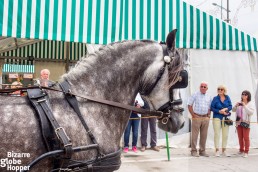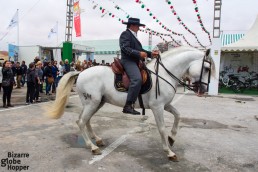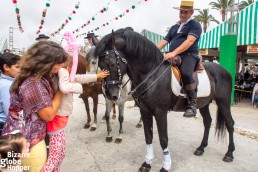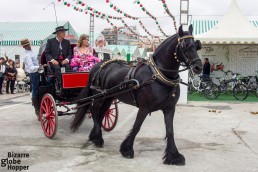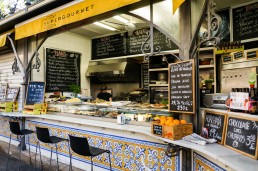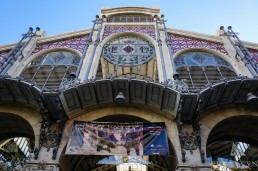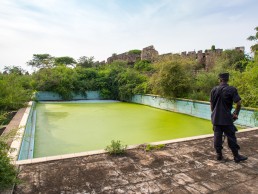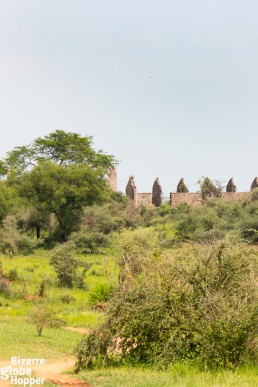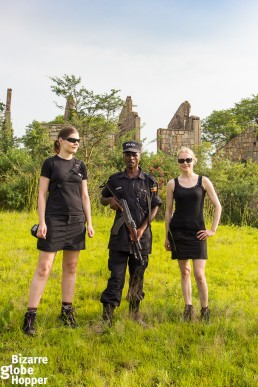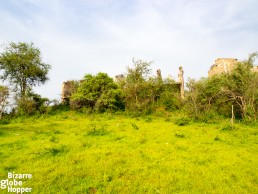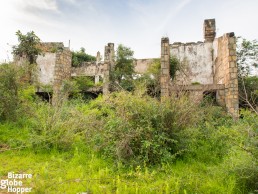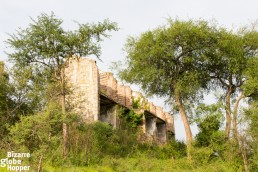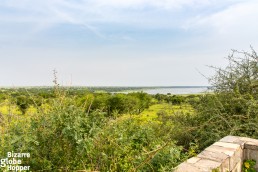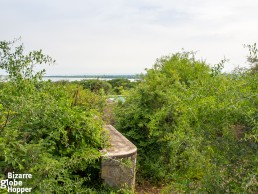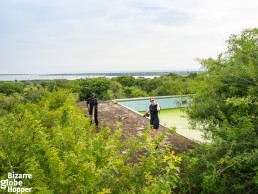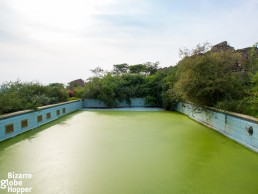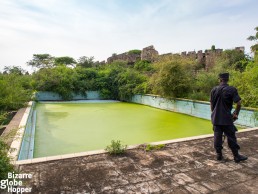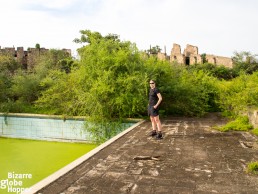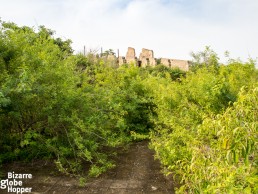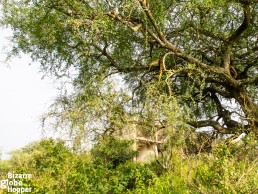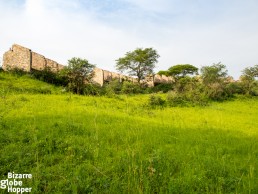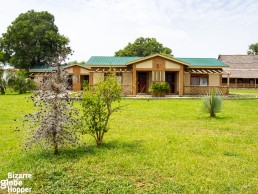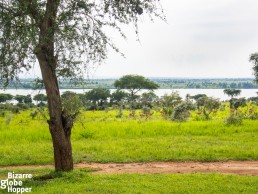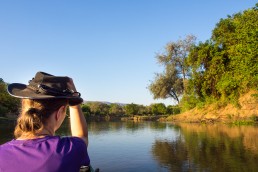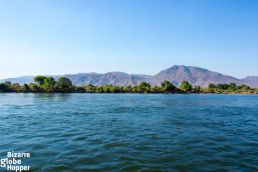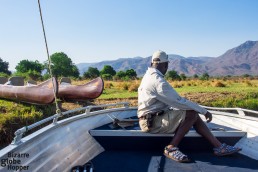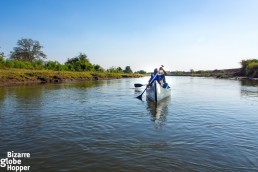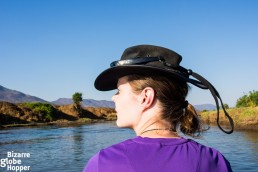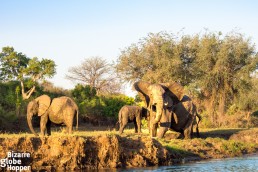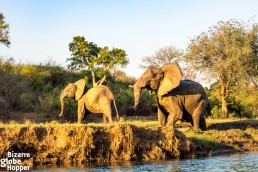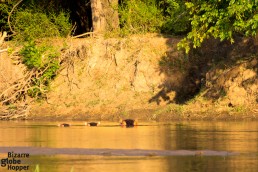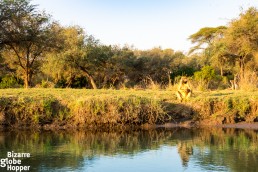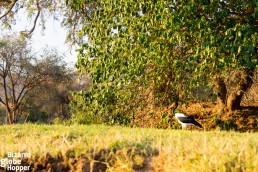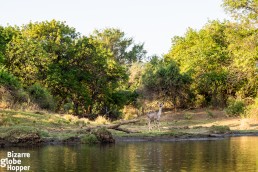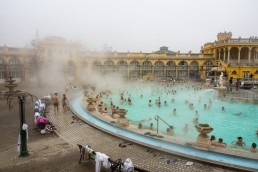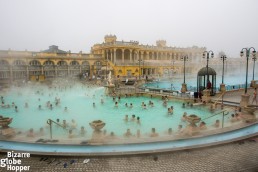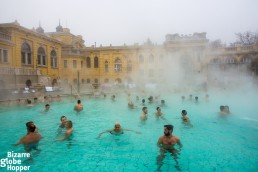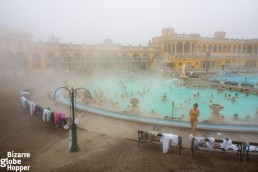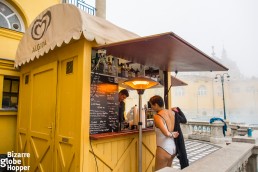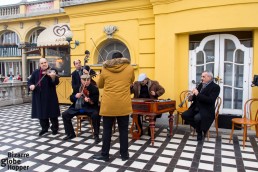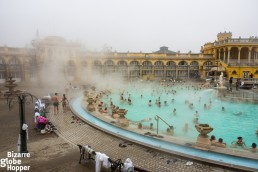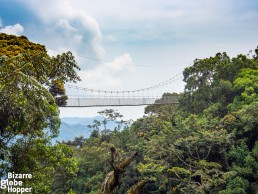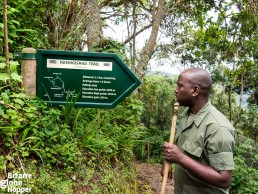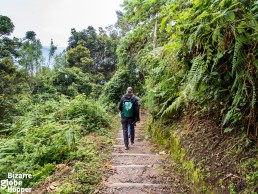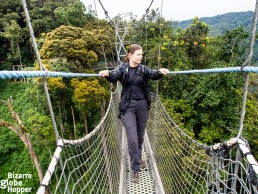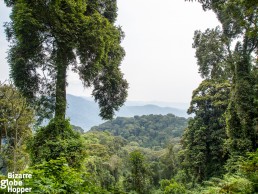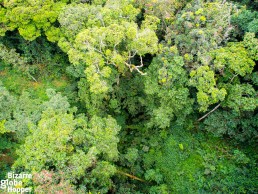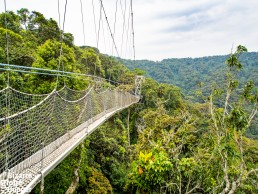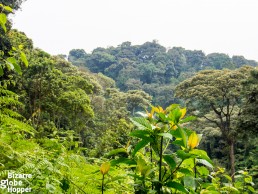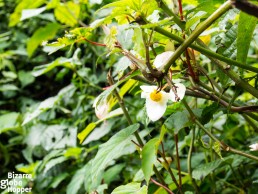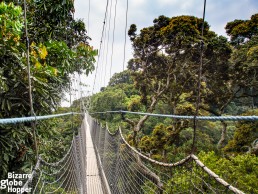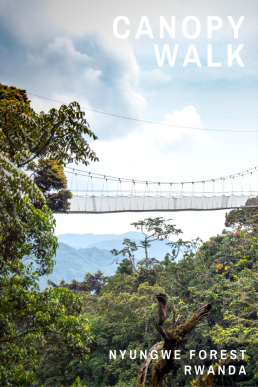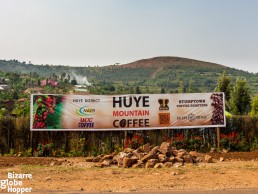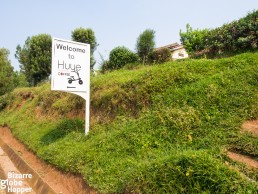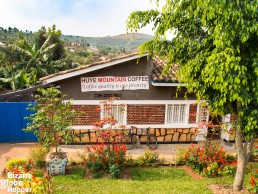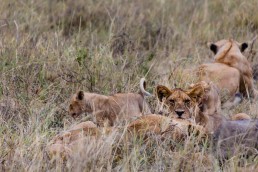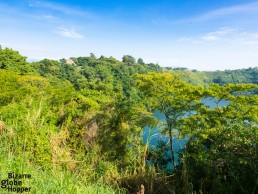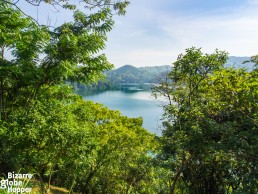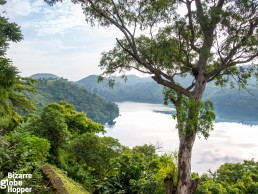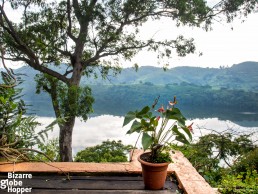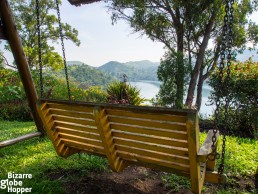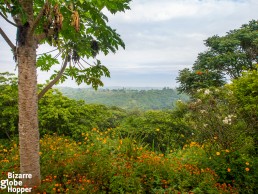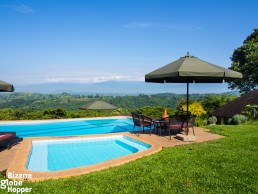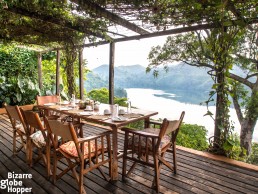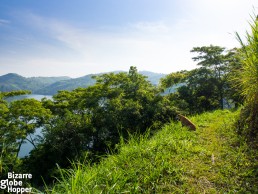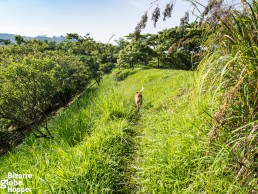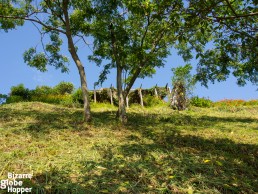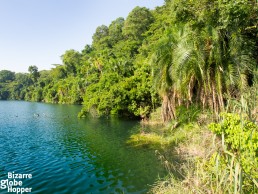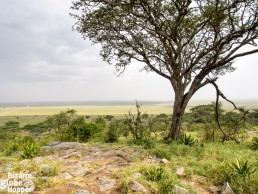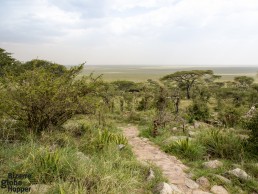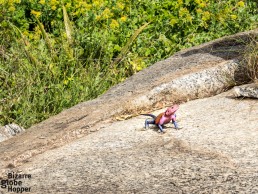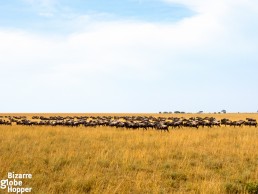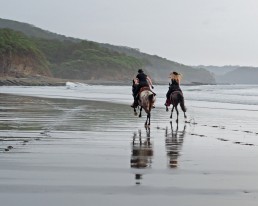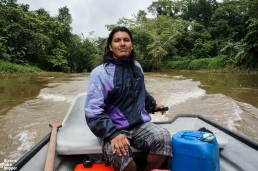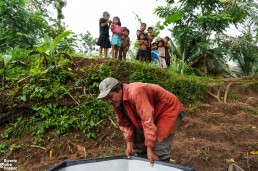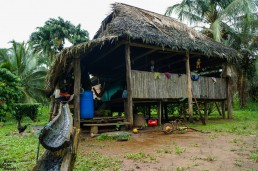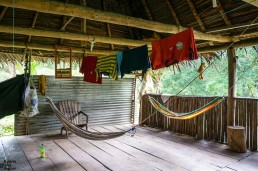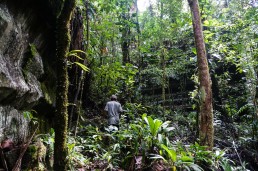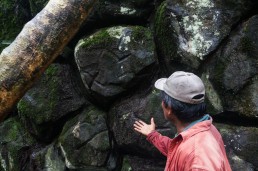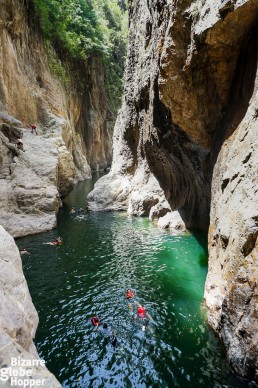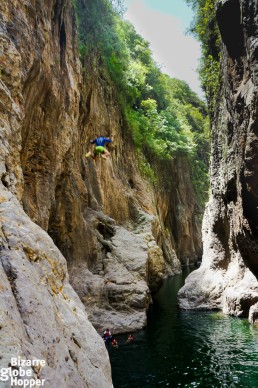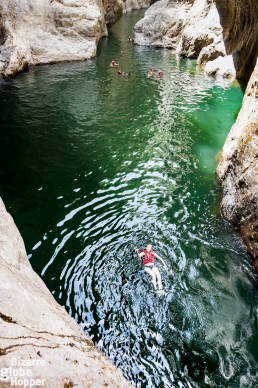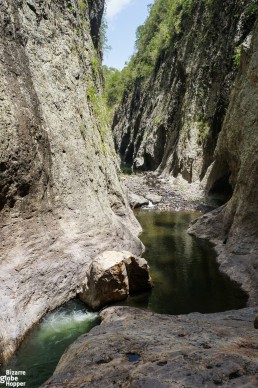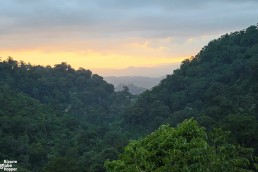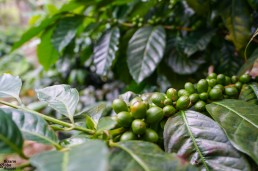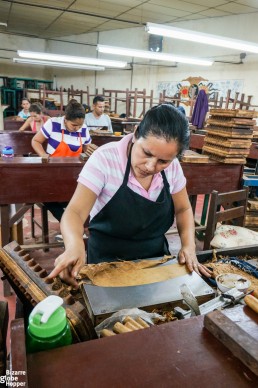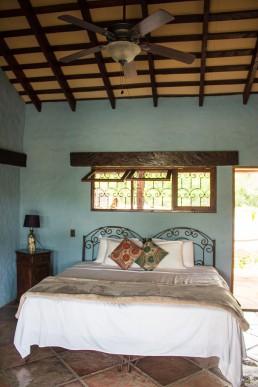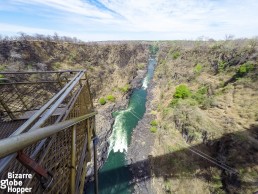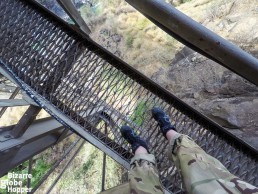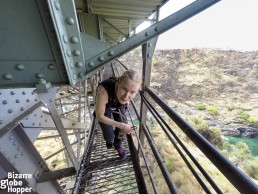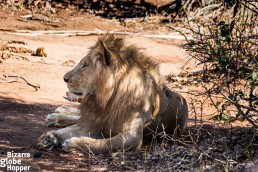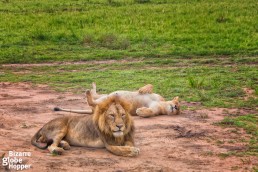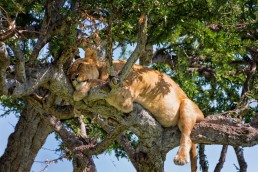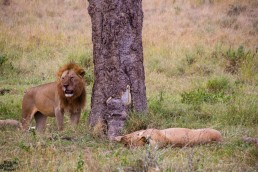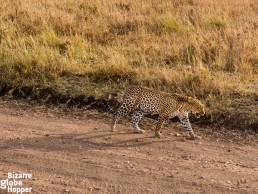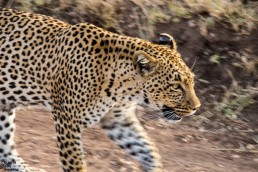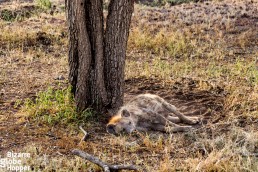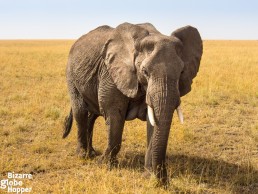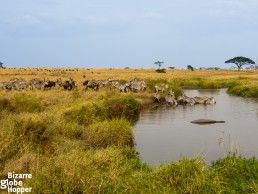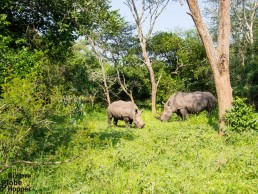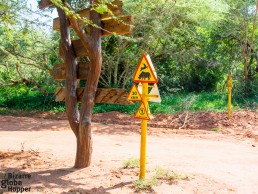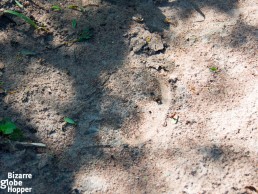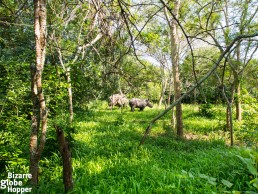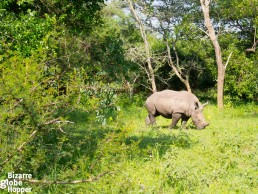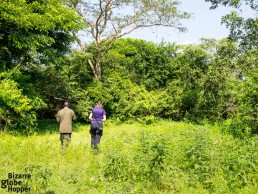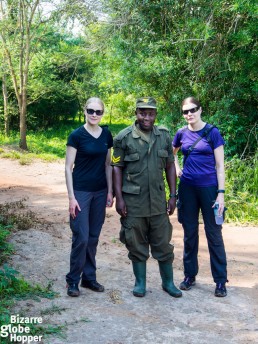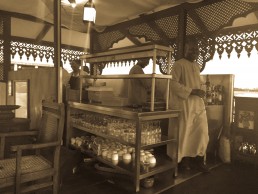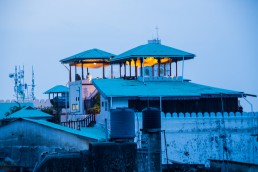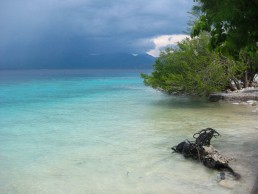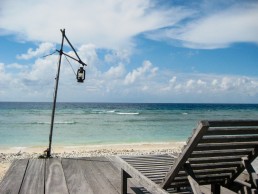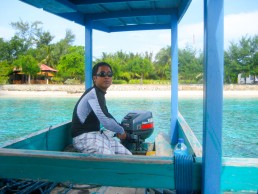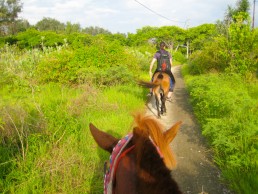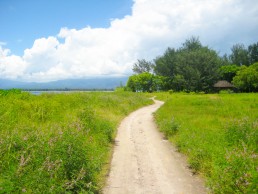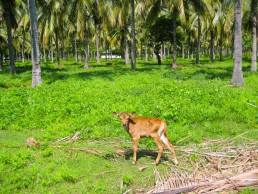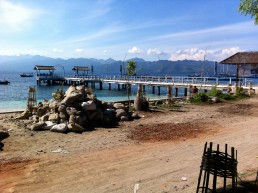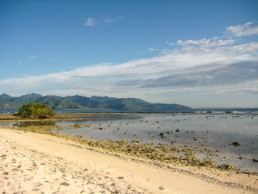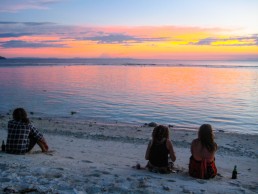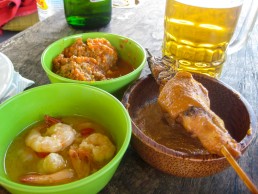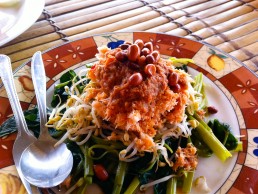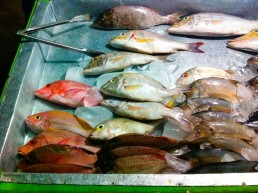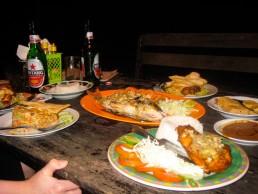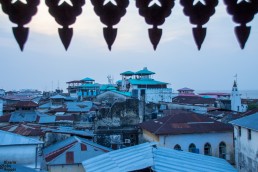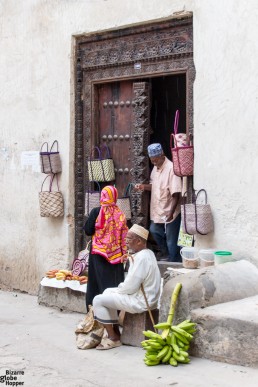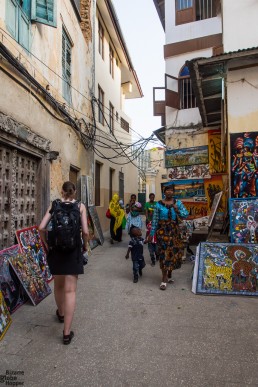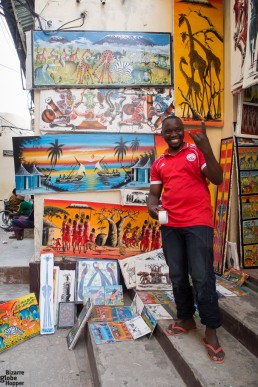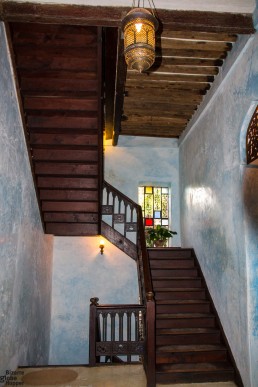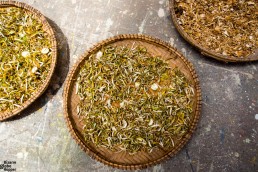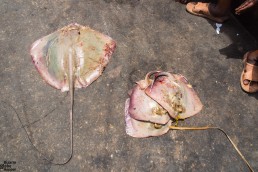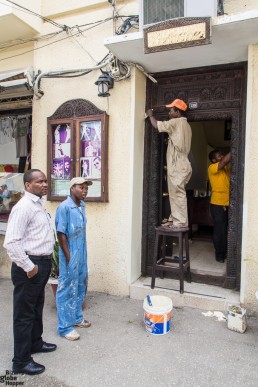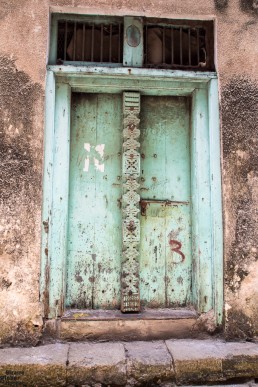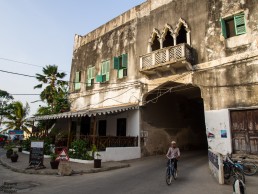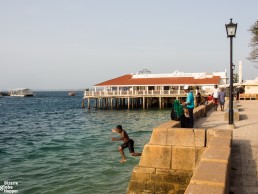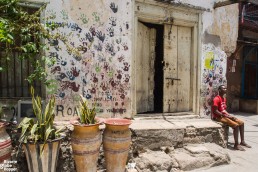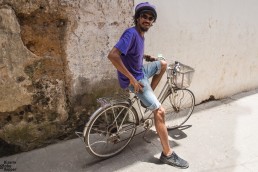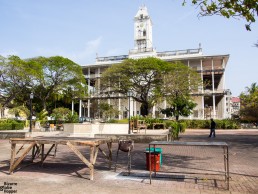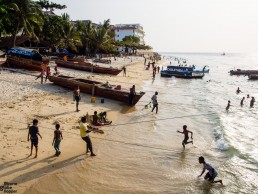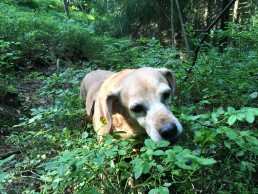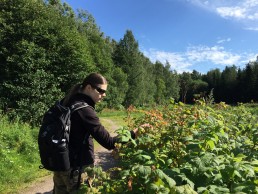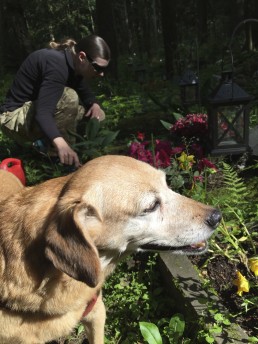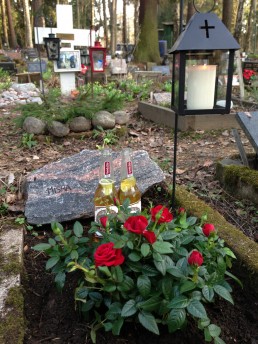Sight of the Week: The Palm Grove of Elche
Have you ever heard of the Europe’s biggest palm grove? Probably not. Still the historic palm grove in Elche rates as a Unesco World Heritage Site and walking below hundreds of years old trees feels invigorating amidst all the traditional sightseeing.
Carthaginians planted the Elche’s first palm trees more than 2000 years ago. Arabs extended the groves and added an ingenious irrigation system that turned Elche into a prominent agricultural player in Spain. Historically, the groves produced dates, and the shady terraces were used for cultivating more valuable fruits and vegetables, such as pomegranates. Even now, Elche produces 85% of Spain’s pomegranates.
Popping inside the Parc Municipal inside the city center is probably enough for an average tourist. Along with the well-manicured palm trees, the city park has delicate implantations, loads of benches in the shade and playing areas for kids. Inside the park also lurks a restaurant, Datil d’Oro, where I love to sip an excellent café solo.
The groves expand outside the center, with altogether more than 200 000 palm trees. Even the urban areas have 70 000 date palms, making the center pleasantly lush and green. If you’re really into palm trees, you might lose yourself in the Museo del Palmeral or love he map that tells stories about the most famous trees (yes, they have names, as well). But even the rest of us will enjoy the walking routes, called ”Sendero del Palmeral”, that cover the groves and other sights on the way. The longest one twines around the city center for more than 10 kilometers, but a pleasant 2-kilometer walk shows you quite enough. If you don’t fancy exercising in the heat, there’s also a tourist train that wriggles through the palm grove and the main sights of the city.
Would you enjoy walking in the shade of the Elche’s palm grove?
Pin this story!
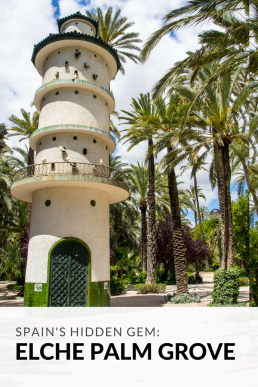
Celebrating Feria de Sevillanas Carneval in Torrevieja
I arrived Torrevieja just in time to indulge in the May Fair called Feria de Sevillanas. Andalucian horses dominate the cityscape: skilled riders are showing off, and colorful carriages are frolicking with each other.
The feast originates from Seville, the capital of Andalucia. However, also the other Spanish cities imitate its’ festive spirits. In Torrevieja, Feria de Sevillanas is celebrated in early May. I enjoy most watching the delicate Andalucian horses, but the locals seem to go crazy dancing ”sevillanas”, a specific genre from Seville. The dance mirrors flamenco, but it’s way easier to master since the choreography is pretty simple. Whole families are dancing the day away in unbelievably ornamental tents that look like old restaurants with massive chandeliers. Women and girls are clad in flamenco dresses which are also sold in the carnival area, along with sombreros and Spanish hand fans.
In Torrevieja, Feria de Sevillanas takes over the port facilities for several days. The main arena is located at the amusement park area, near the breakwater. There are dozens of tents, casetas, selling refreshments and small bites, and almost all of them have a front area devoted to the ”sevillanas”. The horses are parading also in the streets, although the main cavalcades are held in the festival area. In the last evening, the music grows louder and so do the crowds: it’s a serious party before the feast ends!
Have you been in the original Seville Fair or any other ferias around Spain?
Pin this story!
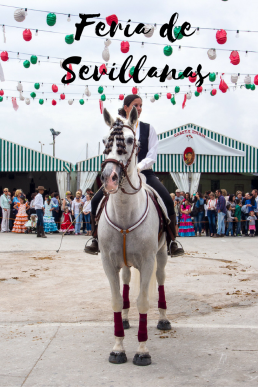
Sample the Tastes of Valencia, Spain
Did you know that the most epic Spanish dish paella is originally from the city of Valencia? And that you might get free tapas with a glass of wine or beer?
Tapas Freebies
In terms of flavor and spiciness, my palate is a bit disappointed with the Valencian food, since most restaurants serve quite a bland fare. The best bet is always to choose tapas: they are usually tasty and offer an easy way to sample different ingredients and flavors. This is also where wine and beer lovers like us get lucky, as some restaurants serve a free tapas with a drink, even with a caña, which is the smallest glass of beer, usually around 2 deciliters. The tapas freebie can be anything from salted peanuts (if you aren’t so lucky) to bocadillo (small sandwich), fried little fishes, or a tiny portion of paella. What a good reason to enjoy a few beers during the scorching afternoon hours and sample what different restaurants have on offer!
Sumptuous Paella
Most restaurants in Valencia serve paella all day, although real Spaniards eat it only as lunch. This time, we ate the most mouth-watering paella at home, made by my stepmother. According to a classic Valencian recipe, our paella included rabbit meat. Other valid options are chicken and duck. In the city of Valencia paella is not supposed to have any seafood whatsoever, but as we ate ours in Torrevieja, we followed their tradition and added shrimps. Saffron, garlic, sweet pepper and lemon are the key elements. But you’ll need a special pan called paellera to get it right!
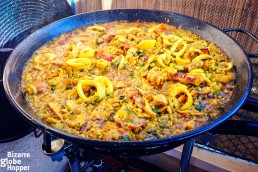
Our Restaurant Picks in Valencia – One Success, One Fail
We did find one recommendable restaurant in the middle of Barrio El Carmen: Carosel. The setting was lovely, and ingredients were first class. Only one complaint, once again: I would have loved to have more seasoning, not just salt. Terrace looked pleasant with views to Placa del Mercat – a good spot for people watching, yet not overly touristic.
Carosel lies almost next to La Lonja de la Seda (an old silk market, one of the main sights) and opposite Mercado Central. It’s easy to find and a good point to start exploring Barrio Del Carmen. I love the small, winding streets between Carosel and Calle Caballeros – lots of graffitis, cozy pubs and fewer tourists. Venture more deeply into the vibe of Barrio Del Carmen area in our previous post about Valencia.
I would have loved to visit also another El Carmen venue called El Tap, which is said to offer delicious tapas accompanied by boutique beers and wines. Alas, they were having renovations back then, but they are open now, so you can try it for us.
We made also one wrong choice based on by then glowing TripAdvisor reviews: R38. The whole eight-course menu was a disaster; only the dessert was edible but in no way perfect. The place is located a bit outside the old town, in an area called L’Eixample, so we walked there half an hour with high hopes but ended up laughing desperately, when each of those miserable dishes arrived.
Yeah, the price was low: 26 euros for seven courses and 1,5 euros for an extra appetizer, but don’t be cheated. Locals seemed happy with this utterly tasteless and weird food, which left me wondering if we just don’t get the real Valencian cuisine. My palate just doesn’t understand why a scoop of totally tasteless potato mash of a weird consistency should be swimming in beef stock together with an egg.
In general, the places near Cathedral seemed touristic and overpriced, but there are some jewels as well. Just choose wisely, ask locals or check TripAdvisor. Most restaurants in old town are so small that reservation is needed, sometimes days ahead. We tried to book a table in Delicat that sounded to be a great Asian fusion tapas joint located just a few hundred meters from Cathedral, but they were sold out.
Have you visited Valencia? Did you find great restaurants? Please share your tips with us!
Exploring the Ruins of Pakuba, Idi Amin’s Favorite Safari Lodge
Visiting the ruins of Pakuba Lodge, Idi Amin’s favorite hideaway in Murchison Falls National Park, is a rare treat. There are just a few remnants left in Uganda from Idi Amin’s atrocious regime. Once the pride of Murchison Falls National Park, the grandiose Pakuba Lodge caught the eye of Idi Amin, who turned it into a State Lodge, his private retreat. The legend has it that Idi Amin spent much more time in Pakuba than in his official presidential residence in Kampala. Pakuba Lodge welcomed Idi Amin’s inner circle as well as international guests of honor and is praised in several memoirs.
I remember seeing a photo of the old Pakuba Lodge in some travel magazine years before visiting Uganda. The sight had haunted me ever since. The lodge seemed to stand alone in the wilderness, upon the serene waters of White Nile, and the name of Idi Amin loaded the image with ominous enigma.
Finding the Way to the Old Pakuba Lodge in Murchison Falls National Park
The derelict of the historic Pakuba Lodge rests deep inside Murchison Falls National Park, in northwestern Uganda. The area has Africa’s highest numbers of Nile crocodiles; one of the predators that Idi Amin loved to hunt for sport, among lions and other big game.
During Idi Amin’s rule, for example, the elephant population of the park collapsed from 9000 to the one scared herd of 160 elephants. It’s also told that tons of human corpses were thrown into the Nile, and drifted through the Murchison Falls, called Kabalega Falls at the time, only the be devoured by the notorious Nile crocodiles.
Fortunately, wildlife populations of Murchison Falls have recovered from the violent poaching of Idi Amin’s era. For us, Murchison Falls National Park offered great lion sightings, and we saw also a gigantic python from a zero distance. Murchison Falls is the biggest national park in Uganda, and among the best for sure. Don’t forget to take a boat cruise on the Nile to spot the infamous crocodiles and other wildlife, and admire the falls!
If you are visiting Murchison Falls, take a small detour to explore the ruins of Pakuba Lodge. It’s probably on your way if you’re doing a couple of game drives in the park. Your guide knows the way, and you can tour nearby bushes and riverfront making it a proper game drive with a break at the Pakuba ruins.
Visiting the old Pakuba Lodge is allowed only with an armed ranger. We were accompanied by a tourist police from our hotel and our guide. There are plans to renovate the Idi Amin’s beloved lodge, but we haven’t heard about any progress.
”We could hear big cats roaring in the Pakuba ruins: the predators have taken over Idi Amin’s paradise. This is their breeding ground, and humans are not welcome.”
Approaching the Old Pakuba Lodge Through Overgrown Vegetation
I had a vague memory of a majestic, low-rise and wide stone complex that was standing alone upon the serene waters of White Nile. When you are visiting Pakuba Lodge ruins, you’ll approach the location from the opposite direction, seeing just some crumbling stone piles rising from the bushes. You’ll notice the isolation, though, as there are no other lodges nearby. Our loyal Land Rover struggled to climb the steep, overgrown path leading to the hilltop. It was evident that the site doesn’t decorate wishlists of ordinary tourists: no-one had penetrated these bushes with a car for a while.
A strange feeling hit me when we reached the hilltop and were welcomed by a clearance in the front of the overgrown reception. The tourist police asked our guide to park the car at the exact spot of the former parking lot. My mind was busy imagining this abandoned hotel in full colors, without overgrown vegetation. I was already seeing the staff hurrying towards us with cool towels and fruit juices on the tray when we were told to jump out and start our exploration.
Plunge into the Bushes and History of the Old Pakuba Lodge
Off we plowed through knee-high vegetation, stylishly unprepared in our short skirts. Silent tourist police led us towards the northern wing of the old Pakuba Lodge, pointing where the kitchen and housekeeping facilities had located. He finally seemed to open up a bit, giving up to our visible fervor and answering our hesitant questions with short stories as we passed different sections of the former State Lodge. When we came around the building, we could, at last, see the fabled view, which is praised in so many memoirs.
Pakuba Safari Lodge was built on the hilltop, facing the photogenic junction of the two Niles and Lake Albert. You can see all the way to the DRC, which was one of the reasons why Idi Amin loved this location. Idi Amin’s tribe, Kakwa, originates from Zaire (now known as the DRC); it was also where he smuggled ivory and gold to trade arms. Murchison Falls used to be the most visited national park in Africa and mecca for hunting, which was obviously the other reason Amin was so fond of this hideaway.
Explore the Ruins of Idi Amin’s Pakuba Lodge
We strolled around the Pakuba ruins, admiring the view and the quiet solemnity that surrounds the former Idi Amin’s State Lodge. Hippos were grunting at the shore, and a herd of elephants roamed at the distance.
It’s fairly easy to imagine the former Pakuba Safari Lodge in its heyday since a wrecked skeleton of the whole hotel complex rises from the high grass. The tourist police told us that two-story building had accommodated 160 people. Each room had a balcony overlooking the Nile junction and Zaire.
The old Pakuba Safari Lodge was designed by the Danish architect Hans Munk Hansen, and 4-year building process was finished during the Idi Amin’s era in 1974. The lodge was built from the local stone; now decayed and eroded in rains. What you can’t see are the balconies and roof structures which were made out of Eucalyptus tree. In the middle of the two wings was the main building with a restaurant, lounge, bar and a large terrace.
Tour Swimming Pool Area of Pakuba Ruins
Out of a sudden, the tourist police plunged through dense bushes but soon came back to tell that we could follow him to the swimming pool area. He had just checked that there weren’t any leopards or lions lurking at the site.
Vegetation was thick. We hopped cautiously upon a stone rail and penetrated further while trying to keep the balance. It was well worth the effort, though.
The swimming pool is clearly the dilapidated heart of the eerie Pakuba Lodge. From here, the view is at its best: on a bright day, Congolese mountains peek visibly upon the Nile junction. We could hear big cats roaring inside the ruins: the predators have taken over Idi Amin’s paradise. This is their breeding ground, and humans are not welcome. Shady stone piles offer a haven for bringing up cubs and hiding carcasses.
After enjoying the grounds for a half an hour or so, the tourist police urged us to proceed, with a slightly jittery tone. We wandered, humbled, around the southern wing and towards the parking lot. Fresh carcasses of an oribi and impala were hanging from a tree, telling that a leopard was probably prowling nearby. We needed to go, the tourist police said even more forcefully.
Recap of Idi Amin’s Notorious Era
Idi Amin’s 8-year reign of horror ravaged Uganda to deep scars. Idi Amin’s regime is held responsible for a half million deaths and bringing one of the healthiest economies in Africa to total ruin. Entire villages were wiped out. Professors, journalists, businesspeople, religious leaders, and ministers just “disappeared”.
The ground was so full of bodies that gravedigging got to deadlock, and the corpses were fed to the crocodiles of Nile. But even the crocs couldn’t handle it, and the bodies were seen at the shore in high numbers. Wildlife was annihilated resulting, for example, the total extinction of rhinos and slaughtering 90% of the country’s wildlife.
Idi Amin: Tyrant, Sadist, and Cult Figure
Remember the Idi Amin movie, ”The Last King of Scotland,” which brought Oscar to Forest Whitaker for playing the whimsical tyrant? The movie gives some foretaste to Idi Amin’s erratic and ferocious behavior.
Idi Amin claimed to be ”Lord of All the Beasts of the Earth and Fishes of the Sea,” among other titles. He stated that human flesh tastes a bit salty, and was known to collect heads in the fridge of his palace. Idi Amin was undoubtedly one of the most notorious men known to history, who also credited the others, claiming for example that Hitler had been right to kill 6 million Jews.
But Idi Amin was also a celebrated cult figure for some, even in other parts of Africa and for example in the Caribbean. At first, he was considered as a black nationalist and a strong, charismatic tribal chief. He knew how to show off in international media, plunging in swimming pools in full military uniform and boasting with numerous wives.
Henry Kyemba’s memoir “A State of Blood” sheds a harsh light to the era and Idi Amin’s life, sparing no gory detail of the brutal murders. Kyemba was Idi Amin’s secretary, and the first insider to reveal the atrocities. I would strongly recommend his book if you’re interested in Idi Amin’s regime. We bought ours in Africa, but it’s available on Amazon, as well.
Searching Ruins of the Idi Amin’s Regime in Uganda
For understandable reasons, it’s kind of difficult to find any physical traces of Idi Amin’s bloody regime in Uganda. Ugandans tend to fall silent about their memories, as well. Even at the Pakuba Lodge, one of the staff members told us that nearby Pakuba ruins had nothing to do with Idi Amin, although the history is well-known.
From what I’ve heard, there are also the ruins of Idi Amin palace at Lake Victoria, and of course, it’s possible to visit all those unfortunate places mentioned in the history books where the mass murders took place – most of them are on the regular tourist route, anyway. Try to ask from your tour company or guide.
Stay at the Nearby New Pakuba Safari Lodge
To crown your expedition into the grim history of Uganda, stay at the new Pakuba Safari Lodge, built among the former staff headquarters of Idi Amin’s Pakuba Lodge. The new lodge was built in 2010 in the shadow the hill, where the old Pakuba ruins lie.
Wildlife roams freely through the property making your stay a constant safari experience. While we were eating breakfast in Pakuba, giraffes peeked into our room. Impalas, hartebeests, and kobs grazed just outside; even elephants wandered around, and big cats roared at the distance. There are not so many lodges nearby in this area, which makes Pakuba Lodge an excellent vantage point for the game drives in Murchison Falls National Park.
It’s good that Uganda is not hold up as the “Idi Amin’s country” anymore. Still, I think that tourists should be educated about the bloodshed and chaos that Idi Amin’s reign caused to Ugandan people and wildlife. We enjoyed visiting the ruins of Pakuba Lodge accompanied by grim tales and deep thoughts. Would you enjoy this kind of dark pilgrimage?
*Disclaimer: Our safari in Uganda, including a visit to Murchison Falls National Park and Pakuba Lodge, was hosted by Mamaland Safaris. All the opinions and views expressed here remain totally our own.
Pin this story!
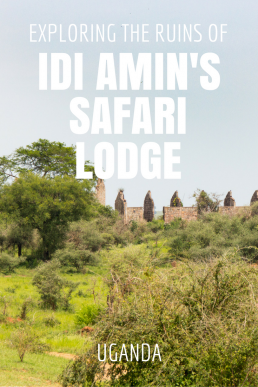
Canoe Safari on the Scenic Zambezi River, Zambia
Canoe safari on the Zambezi offers the most serene version of “game drive” I can possibly imagine. Floating silently pass animals gives an entirely different perspective to wildlife watching. Canoeing is unbelievably relaxing, yet thrilling experience since the distances to the animals might be minimal, and you don’t have the same kind of protection than in a car.
Canoeing is a slow means of transport for sure, so if you urge to see tons of wildlife in just a couple of hours, canoe safari might not be the best option. Nevertheless, during our canoe safari in Zambia, we managed to see a comprehensive palette of game similar to the standard game drive. The secret is to know where to paddle and which is the best timing to see animals who tend to come for a drink.
Canoe Safari Through a Calm Channel in Lower Zambezi National Park
Our canoe safari took place in Lower Zambezi National Park, on the drastic Zambezi River. The Zambezi cuts land for more than 500 kilometers between Zambia and Zimbabwe. This 3500 km long river curls all the way from northern Zambia to the Indian Ocean passing also Angola and Mozambique on its way. We could actually see Zimbabwean shore while we were paddling, just like we saw it on our rafting trip as well. Most canoe safaris in Zambia, and likewise in Zimbabwe, are organized on the Zambezi River for obvious reasons.
Since we were staying at the plush Royal Zambezi Lodge, we canoed down a nearby channel, accompanied by their guide. Calm and shallow waters of the channel make canoeing enjoyable and let you concentrate in wildlife spotting. You don’t even have to paddle since it’s just 6 km downstream, and your guide is paddling in the rear anyway. The stream will push you forward quite effortlessly without strenuous exercise.
The subtle evening light softens the scenery. We are the observers taking notes on how baboons solve their domestic issues and sit by the sandbanks waiting for the sun to set – just like we humans do. Male elephants are trumpeting to show their muscles; crocs lie in a shallow water mouths wide open, waiting for the food to pour in. We are part of the scenery, but feel the animals’ eyes on us, as well.
The Wildlife Scores of Our Canoe Safari
But what is there to be seen on a canoe safari, then? On top of the serene river scenery, we saw herds of impalas, some kudus and zebras, tons of elephants, cute tiny crocodiles, hippos plunging and splashing, and baboons playing and fighting. Then there were kingfishers, bee-eaters, hornbills, and tens of other bird species, whose names I regret to forget every time. I had to ask our guide how many species he can identify, but the answer left me even more awestruck: more than 1000 birds, which all could be seen in the Lower Zambezi National Park.
Every animal, except hippos, crocs, and birds, had wandered to the shore of the Zambezi on purpose: they needed an evening drink. Since we paddled down a channel that is only 10 to 15 meters wide, animals were close to us and appeared to approach us as they walked towards the water. Our guide paddled so quietly that the animals didn’t spook out at all and we could enjoy the sublime wildlife scenes.
Canoe safari offers a new vantage point that makes seeing even the “typical safari animals” unique. Still, I’d say that the wildlife is not the main draw on a canoe safari, as weird as it might sound. The tranquil atmosphere took us by surprise, and the canoe made us merge in the environment. The subtle evening light came from behind us, softening the scenery. We were the observers taking notes on how baboons solved their domestic issues and sat by the sandbanks waiting for the sun to set – just like we humans do. Male elephants were trumpeting to show their muscles; crocs were just laying in a shallow water mouths wide open, waiting for the food to pour in. We were part of the scenery at that very moment, but felt the animals’ eyes on us, as well.
Is Canoe Safari on Zambezi Safe?
On a canoe safari, there’s a just a tiny, flippery boat between you and the wildlife, so no-one can guarantee that nothing could happen. However, with a cautious behavior, you can avoid most of the dangers.
Rule number one: avoid moving around in a canoe, sit still and make sure that you aren’t leaning too forcefully towards any direction. Keep your limbs inside the canoe since crocodiles are opportunistic eaters. If you fear water, wearing a life jacket might calm you, though it gets sweltering with one.
Rule number two: respect hippos. When you confront a hippo during a canoe safari, give it enough space to either pass you or stay where it is. Never block the way, if a hippo is moving. Hippos are usually not aggressive if they aren’t agitated. But they will consider it a thread if you go too near or block their way – and then nobody knows what might happen. With these precautions in mind, you should be safe.
We were drifting with our cameras in hand, but it’s a lot wiser to take a dry pack or cover your valuables otherwise during the canoe safari. I asked our guide if he had ever flipped the canoe with guests, and he nodded laughing. But it had only happened once after the guest had leaned carelessly to one side to take a picture. So take caution, unless you don’t want to get personal with hippos and crocs, or soak your equipment.
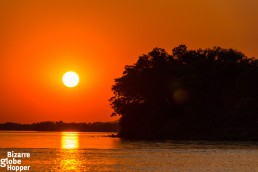
Where and When to Canoe on the Zambezi?
It’s quite possible to canoe anywhere on the Zambezi, like on the raging rapids that we rafted, although it requires great skill. If you are a canoe safari first-timer like us, I would suggest a calmer spot and preferably a channel. To optimize wildlife watching, start your canoe safari a couple of hours before sunset: we departed at 3.30PM whereas sun began to sink at 6.30PM. Many lodges in Lower Zambezi National Park use the same channel that we paddled. Nevertheless, we had the whole channel for ourselves and didn’t see any other canoes. Canoeing the 6-km stretch downstream (one way) took approximately one hour at a very leisure pace and constant stopping for photos. We had a motor boat transport from our lodge to the
Many lodges in Lower Zambezi National Park organize canoe safaris in the same channel that we paddled. Nevertheless, we had the whole channel for ourselves and didn’t see any other canoes. Canoeing the 6-km stretch downstream (one way) took approximately one hour at a very leisure pace and constant stopping for photos. We had a motor boat transport from our lodge to the channel and witnessed an amazing sunset on our way back. What a way to end a perfect afternoon on the Zambezi!
*Disclaimer: Royal Zambezi Lodge hosted our canoe safari, and we were touring Zambia with Zambian Traveller, but all opinions remain our own.
Pin this story!
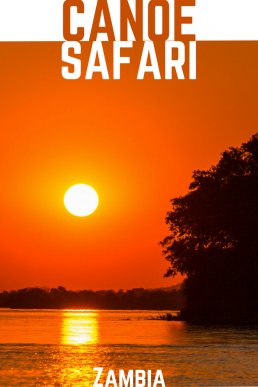
Széchenyi Baths Winter Experience: Budapest Thermal Baths at its Best
Challenge your stamina by visiting Széchenyi Baths on a freezing winter day. Steaming, thermal water invites you to join locals playing chess or just enjoy the massaging whirlpools while snowflakes land on your bare skin. Before you visit Széchenyi Baths or Budapest’s other thermal baths in winter, check out what to expect and pack, how to skip lines, how many hours you’ll need, and other practical tips. Be ready for a real immersion in the Hungarian spa and bathing culture!
In wintertime, the yellow Neo-Baroque buildings of Széchenyi Baths are wrapped in intense fumes. For us, it was hard to choose which was the best part of the outdoor bathing experience: the fairytale scenery, the simultaneous sensation of hot and cold, or the healthy feeling we got afterwards. After spending a couple of hectic days of sightseeing in Budapest, we just loved wading in the light blue water of Szechenyi Baths, letting the thermal water do its magic for our sore muscles.
What to Expect From a Visit to Szechenyi Baths in Winter?
Budapest is the City of Baths with 118 natural thermal springs. You can’t reach its soul without visiting, at least, one of the world-famous spas or baths like they’re mostly called here. Szechenyi Baths is a good start, year-round. The palace-like building, dating back to 1913, hosts one of the most renown spa baths in Budapest, also scoring among the city’s main attractions.
Even so, the bathing experience remains authentic, probably because Széchenyi Baths is a local favorite, as well. Szechenyi Baths is one of the biggest spas in Europe and can accommodate more than 1500 people, so usually it won’t feel crowded.
The enormous outdoor baths were the highlight of our winter visit in Szechenyi Baths, so give it a try! If you ask me, winter is the best time to soak in the steaming thermal baths. You won’t feel the coldness – it’s bliss!
Széchenyi Baths is Not Luxurious Spa but a Local Bathing Experience
The heavily decorated, stunning façade of Szechenyi Baths gives a promise of luxurious spa treatment. However, the real experience is pretty down to earth. After passing through grandiose entrance hall beneath the baroque dome, you’ll descent the hallway to the showers and changing rooms. It feels a lot more like visiting a public swimming hall than a spa.
The cheapest ticket (HUF12500 on weekdays, around 32€; Fridays, weekends and holidays are more expensive) provides a communal changing room with a locker for clothes and handbag or a small backpack. If you pay just a couple of euros more, you’ll get a tiny, but private cabin for changing clothes and leaving your valuables behind. We tried both, but for your comfort, I’d recommend the latter. Tip: Nobody will tell you that it’s completely acceptable to share one cabin, although they are extremely tiny, and you won’t fit in together.
The showers, found in downstairs, have more or less public swimming arena feel. My mother, who was traveling with us, described the environment as prison-like, so don’t expect anything fancy. But I’ll promise that you won’t have any regrets after climbing the stairs up to the bathing area!
Which is Better in Winter: Szechenyi Baths or Gellert Baths?
Many people recommend Gellert Baths during the winter since they have even more attractive indoor pools and most foreigners are afraid of swimming outside in cold weather. As said above: Szechenyi Baths in winter is the ultimate thermal bath experienced don’t skip it! But if you’re also interested in visiting Gellert Baths, we’ll list some tips and differences below.
Gellert Baths feels more touristic and usually gets filled up to the utmost. In Szechenyi Baths, you’ll have more elbow room, though you probably still need to squeeze in the smallest sitting pools.
Budapest has more than a dozen bathhouses, each with a distinctive character, so if you linger more than a couple of days, I’d suggest visiting two different kinds of baths. Szechenyi and Gellert are both from the same era; then there are several bathhouses dating back to the Turkish period, some of them a bit ruinous and completely non-touristy. Szechenyi and Gellert are the best thermal baths in Budapest – visit at least one of them, and if you ask me, let it be Szechenyi Baths!
Soaking Through 18 Pools and 10 Saunas of Szechenyi Baths in Winter
We were so excited to try the outdoor pools that we defied the crisp winter weather and hurried towards to steamy outdoor pools wrapped in towels. Dipping into the 38-degree water felt heavenly after shivering from the cold. It’s advised to stay in the hot pool only for 20 minutes, but I’m quite sure we stayed more than half an hour just floating around, watching locals playing chess and admiring the gorgeous buildings through the steam. I felt how my muscle pains just melted away.
Our Favorite: Szechenyi Whirlpool Pool
After the hottest outdoor thermal pool, we plunged in the “Whirlpool Pool” at the other side of the inner yard. At the time, the water temperature was just a couple of degrees colder, still delightfully hot. Szechenyi’s Whirlpool Pool has small massaging jets and a waterfall, and a funny adventure pool where a strong whirlpool transports you quickly around a circuit shaped pool, pocketed in the center of the “Whirlpool Pool”. We had a blast floating and swimming through the labyrinth-like whirlpool corridor, avoiding bumping accidentally to other bathers and laughing out loud. After having some fun, don’t skip the small jacuzzi in the middle of the circuit.
“Whirlpool pool” was our favorite, where we kept coming back. I’d suggest starting your bathing experience from it and then move to the even warmer outdoor pool for a soothing bath experience.
After soaking in thermal pools of Szechenyi for more than half an hour, the chilly winter day finally chased us forward. The third outdoor pool is designed for swimming laps, so the temperature is near normal swimming pools (27 degrees), rather chilly in winter conditions. I was happy with a short swim, but Piritta just dipped in her toes, shivering from the cold.
Different Saunas in Szechenyi Baths – Did They Impress the Sauna Loving Finns?
Stone floor felt so freezing that we wanted to run inside, but it’s also so slippery that you have to be cautious when walking barefoot. We were more than looking forward popping in one of the saunas of Szechenyi. At this stage, I have to remind that we come from Finland, the country of sauna culture. We even have a small sauna in our apartment which we use every week, and we have been pampered with wood-fired saunas in the Finnish countryside all our lives. As to saunas, we are hard to please. And that’s why even the much praised Szechenyi Baths failed to prove its saunas to us.
Most of the saunas in Szechenyi Baths are more like steam rooms, or Turkish saunas if you wish. There is one huge Finnish sauna downstairs, but I need to emphasize that Finnish people wouldn’t call it Finnish sauna. In Finland, saunas are way hotter and you are supposed to throw water on the stove regularly to get hot steam. The Finnish sauna of Szechenyi is way too cold and dry to be called a Finnish sauna. Still, it seemed to impress other tourists, as the temperature hovered around 70 degrees. Nevertheless, we enjoyed warming in the saunas and steam rooms between cooler pools – and of course, we had to try them all! Some had aromatic medicinal steam; some were so steamy that you couldn’t see others beside you. Breathing in the steam felt exquisite.
Indoor Pools in Szechenyi Baths Have Water Temperatures from 16 to 38 Degrees (60-110F)
Naturally, we inspected all the indoor pools of Szechenyi, as well. Water temperatures range from freezing to hot (16 to 38 degrees, or 60 to 110 Fahrenheit). Most plunge pools accommodate just a handful of people and are in modest surroundings, but there are bigger pools in attractive halls, as well.
We could easily fit in all the pools though some smallest sitting pools were pretty full. For some reason, the coldest pools were empty all the time. I dipped in all of them, although the 16-degree water felt excruciatingly cold even for me. That’s the normal temperature of Finnish lake or sea water in June, which already entices people to swim. I’ve also done some winter swimming, meaning dipping in a hole in the ice. So I should be more seasoned for cold water than most people. I adore the euphoric feeling after a cold dip; it really gets your endorphins flowing. Challenge yourself and try the coldest pool, located downstairs by the Finnish sauna!
Szechenyi Baths is Not for Kids – Luckily There Are Family-Friendly Spas in Budapest
We loved the fact that the Szechenyi Spa is designed for adults. Kids under 14 are not allowed in the thermal baths for health reasons, and Szechenyi is all about thermal baths. Kid-free (and splash-free) environment adds up to the serene bathing experience if you ask me.
While Szechenyi is not the best bathhouse for families, there are many other alternatives with pools specially designed for kids (with slides and other fun stuff). For family-friendly bathing experience, check out for example the huge AquaWorld Water Theme Park, where you can also stay overnight!
The Healing Powers of Szechenyi Spa
The waters of Szechenyi Baths come from natural hot springs, just like in Iceland or Japan. Naturally hot water is cooled down to suit bathing. Rich in beneficial minerals, such as calcium, magnesium, sulfite, and sodium, these pools are said to have healing powers. You can also recognize the intense smell of sulfur by the inside pools. After a couple of hours in Szechenyi, you’ll feel rejuvenated for sure.
The medicinal waters are recommended to joint illnesses, arthritis, and orthopedic injuries. Every pool has a sign telling its temperature and mineral content, but only in Hungarian. If you are looking for something special, just ask somebody. We played it safe and soaked in each and every one of them! No harm in testing all options, if you don’t have any health concerns.
Tips for Szechenyi Baths Visit
I wish that we would have known couple things before visiting Szechenyi Baths, so I’ll share these tips to help you out.
Bring your own towel (or buy one)! Towels are not currently rented in Szechenyi but sold for 6000HUF (around 15€), so it’s super expensive. In winter, I would take 2 towels since one is constantly wet (you walk around with a towel around you and dry yourself repetitively when switching pools). While you’re bathing, the towel is just lying around nearby, so it’s not particularly clean afterwards. By taking your own towel you’ll also avoid the long queues at the cashier. They sell also bathing suits, but you’d probably like to have your own (the stock is also limited). If you feel chilly easily, bathrobes are available for120000HUF – recommended in the wintertime.
Bring (or buy) flip-flops – we regretted not having ones since floors in these kinds of bathing houses don’t feel especially clean and walking outside barefoot feels freezing in winter. There are no soap, shampoo, or facial wash; so bring your own chemicals. There are hairdryers, though. Swimming caps are required in the one and only pool: the outdoor swimming pool where you can swim laps.
At the cashier, you’ll get a plastic armband, which doubles as your ticket and key. You can open your personal cabin or locker by just pressing the armband against the lock. It’s easy, but most tourists seem to struggle with it. Don’t lose the wristband or any other rented gear, as you’d be punished with a hefty fee.
In Szechenyi Baths, women and men have separate communal changing rooms and showers, but all the bathing areas are mixed. Wearing a bathing suit is compulsory, as it’s also to shower before every pool and sauna. Just watch what locals do if you feel nervous about the bathing etiquette. Leave behind expensive jewellery and watches: thermal water can change the color.
Don’t forget to take a water bottle with you! Hot pools and steam rooms leave you dehydrated. There are water fountains where you can fill up your bottle (or you can buy bottled drinks).
A small kiosk at the inner courtyard, beside the outdoor pools, sells refreshments. It’s allowed to drink alcohol in the baths, so if you’d fancy a hot or cold drink, don’t forget to take some forints with you! There’s also indoor café / restaurant if you’ll get hungry. It’s totally fine to come with your own drinks and snacks, as well. Smoking is prohibited both inside and outside.
One last tip: reserve at least 2 hours for the bathing experience and don’t plan a massive sightseeing tour afterwards. After all the hot pools and steam rooms of Szechenyi Baths, you’ll feel healthy but exhausted.
The Most Important Tip: Book your Szechenyi Spa Tickets Online to Avoid Queues
Luckily we were wise enough to book our tickets via our hotel, so we could avoid the exhausting queues at the spot. Don’t think twice: book your Szechenyi tickets in advance to avoid all extra hassle at entrance, you might lose easily an hour without a pre-booking!
Click here to book your Szechenyi Spa ticket online, so that you enter through a short VIP queue. We had just one couple before us, whereas the regular lines were more than 100 meters long! We strongly recommend to book a cabin (your own changing room) instead of just locker for your privacy and convenience (you can choose a cabin when booking online).
How to Get to Szechenyi Baths in Budapest (Szechenyi Furdo)
Szechenyi Baths lie on the Pest side of the city, by the leafy City Park. Getting there is super easy: take a yellow metro line (M1) to the station Szechenyi Furdo, aptly named according to the bathhouse. When getting out, you’ll see the yellow baroque palace on your right side. That’s the Szechenyi Baths building you’re looking for! Just pass the building until you reach the street; follow it a few steps to the right until you’ll reach the main entrance. You want to use the Szechenyi main entrance since the cashier, lockers, and cabins are there.
Share the fun! Have you visited Szechenyi Baths or some other bathhouse or spa in Budapest during the winter months?
Pin this story!
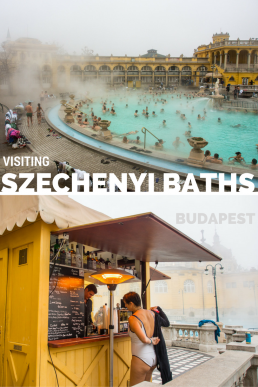
Canopy Trekking in Nyungwe Forest, Rwanda
Nyungwe Forest is an acclaimed chimpanzee trekking destination, but it’s also home to East Africa’s only Canopy Walkway. This time, we took another perspective into the untouched rainforest canopy, walking upon the wildlife and centuries old treetops. And what a thrill it was!
The rainforest of Nyungwe dates back to hundreds of thousands of years – it survived even the Ice Age! Imagine countless, jazzy butterflies flying around you, more orchid species than you’ve ever seen, and birds that aren’t seen anywhere else in the world. Then there are vicious snakes hiding in the twigs and the tension of seeing one of the 13 primates inhabiting this unique ecosystem – at least you’d probably hear monkeys shouting in a distance. Add to that the adrenaline kick of the 60 meters high canopy walkway, and well – you have the adventure to remember!
What Makes Nyungwe Forest Canopy Walk so Intimidating?
The dizzying, suspended walkway hangs upon a steep, lush ravine. It’s said to be 160 meters long and 60 meters high, but the sheer numbers don’t make it terrifying. We’ve been canopy trekking in Costa Rica, and probably on higher platforms, yet this Rwandan canopy walk proved to be a true challenge for me.
There was something magical and pure in this Rwandan canopy experience. One of oldest forests in Africa sets almost a surreal frame around the modern canopy walkway. We had walked in the pristine rainforest for awhile before confronting this majestic suspension bridge all of the sudden – and there weren’t any others around. In Costa Rica, the canopies were crowded, and I could see other people safely crossing the elevated walkways, which eased my nervousness.
In Nyungwe, we were the first and the only ones crossing the terrifying suspension bridge, which swayed under our feets ominously. I mean, the canopy didn’t just shake, like I was used to in Costa Rica, it was swinging from side to side. It took awhile to get used to the movement and the height. But after the initial fear, I was thrilled! We were free to walk back and forth as many times as we pleased, spotting birds and snakes and enjoying the breathtaking views to Uwinka Ridge, the deep gorge under our feet and the lush forest canopy at our eye-level.
Nyungwe Canopy is the perfect place to win your fear of heights. I’m afraid of heights and bridges, but I was able to cross the canopy after a short hesitation. We were hiking with one girl, who was seriously vertiginous, still even she managed to win her fear. The canopy is short enough to make the idea of walking on it still somehow tolerable. Since we made it, you can do it as well!
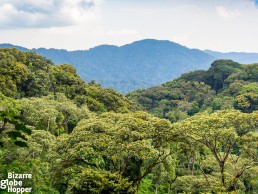
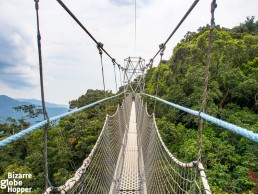
Hiking in Nyungwe Forest National Park
Nyungwe Forest National Park offers an authentic visit to the untouched rainforest. It’s not spoiled by mass tourism; still, the trails are in good condition. Nyungwe’s extraordinary biodiversity makes it an exciting spot for hiking; not only for primates but 310 species of bird and hundreds of orchids along with more than 1000 species of other dazzling plants. On top of 13 primates, there are more than 60 species of other mammals lurking in the canopy of Nyungwe Forest, many of them endemic to this Albertine Rift montane forest. Covering approximately 2000 square kilometers, Nyugwe is largest mountain rainforest in Africa. Unfortunately, it’s also one of the last remaining mountain forest ecosystems in whole the continent.
The Nyungwe canopy walk, along with the other colored trails, starts at Uwinka Visitor Center. There are no park fees, but guides are mandatory, so you have to pay a trek fee (including guide). Canopy treks are possible year-round and cost 60$. You’ll need sturdy shoes and rain gear – it’s rainforest after all. The hike isn’t demanding, though there are some steep ascents and descents. The canopy walk is accessible also as a part of hiking Igishigishigi (the official canopy trek), Imbaraga, or Umuyove trails. Nyungwe Forest Reserve has over 130 km of trails for all fitness levels. Some (uncolored) trails, like the popular Waterfall Trail, start at Gisakura Visitor Center.
For chimpanzee trekking, Nyungwe has two habituated groups, but sightings are not guaranteed. The canopy walk proved to be a perfect small adventure on its own, and we didn’t feel the need to go chimpanzee trekking, as we had done that already in Uganda.
Visiting Nyungwe Forest National Park
Nyungwe Forest became a national park in 2005 when Rwanda aimed to boost tourism beyond gorilla trekking in Volcanoes National Park. Nyungwe’s trail system was formed already in the 1980s, but the war and genocide destroyed the facilities, and most of the staff were forced to flee.
Nyungwe Forest National Park lies in the southwestern corner of Rwanda. The nearest town is Cyangugu, 54 km away at the shore of the beautiful Lake Kivu. Our trip took us from Cyangugu to Kigali, through the vast Nyungwe Forest. The drive was blessed with fairy-tale sceneries and pleasant stops, like a local coffee farm. It takes about 5 hours by car from Uwinka Visitor Center to Kigali. Uwinka Visitor Center has a new interpretation center and a lookout with a beautiful view, making it an excellent place to break the journey even though you wouldn’t be taking the canopy walk or any of the Uwinka treks.
Our visit to Nyungwe Forest National Park and canopy trekking tour were hosted by Lobelia Tours & Travel Agency but all opinions remain our own.
How Find the Best Rwandan Specialty Coffee Beans - Both in Rwanda and Overseas
Join us in search of the best Rwandan coffee beans – both in Rwanda and overseas! Get to know the history of Rwandan coffee trade, how to identify high-quality specialty coffee beans, and where to find and taste acclaimed high-altitude Rwandan coffee.
How We Ended Up Searching For Rwandan Coffee Farms
I fell in love with the distinctive red berry aromas of Rwandan coffee a month before our visit. The flavor profile of Rwandan coffee that I tasted in Finland was completely different from the other African coffees I had cupped before. That’s why I became obsessed with finding the best specialty coffee beans on our drive through the luscious, terraced hills of Southern Rwanda.
We had already toured Rwanda for a couple of days, traveling from Kigali to Kibuye on the shore of Lake Kivu, sailing through the idyllic landscapes to Cyangugu and crossing the epic Nyungwe Forest. I had been frantically googling where we could find the best specialty coffee beans on our route back to Kigali until I stumbled upon Huye Mountain Coffee.
With Huye Mountain Coffee, everything clicked. Their coffee farm is located straight by the Butare (also called Huye) – Kigali road, so we didn’t even have to make a detour. The coffee is labeled as ”high-altitude”, which is one of the primary criteria when you’re searching for high-quality coffee beans. When we left Nyungwe Forest after our canopy adventure, our tour guide called Huye Mountain Coffee to get a green light for our visit. I could hardly hide my excitement!
How to Find High-Quality Coffee Beans in Rwanda – And Overseas
This might already sound so snobbish that I have a confession to make. I’ve grown into an irritant coffee hacker after I switched back to coffee from green tea a couple of years ago. One reason is that my stomach can only tolerate high-quality beans since they have fewer pesticides, chemical fertilizers, and mold – all distressingly generic to ordinary coffee. The average joe just gives me stomach problems and brain fog, whereas ”the real thing” stimulates my mind and body as coffee should.
Finding the best coffee beans in any coffee producing nations has the same principles. My main tips:
If coffee grows at high altitudes, the soil is so rich in minerals that there’s no need for chemicals. If the soil is volcanic, you’ve hit the jackpot!
”Pure coffee” is obviously better for your health, but it tastes better, as well. High-altitude coffee tends to be more complex in taste, showing up the distinctive character of the bean variety. That’s the case with Rwandan coffee, as well.
High elevations provide optimal growing conditions for the coffee trees, bringing out the best of the beans. Cooler temperatures slow down the ripening process, producing a deeper flavor profile. The beans become harder, less watery, and dense with flavors.
World’s finest coffees grow higher than 1300 meters, usually in volcanic soil. In Rwanda, that’s almost the norm. Most of the Rwandan coffee grows in altitudes between 1200 and 1800 meters above sea level.
I like my coffee washed a.k.a. wet-processed. That’s also almost the norm in Rwanda, as many villages have communal washing stations for small farmers. Wet-processing creates a clean taste profile. It’s also healthier than “natural” or “dried” coffee, as washing removes mold. This is, of course, a matter of taste.
But forget about the lecture, let’s get back to Rwandan coffee and how it tastes!
How Does Rwandan Coffee Taste Like?
Rwandan coffee has so distinctive and complex taste profile that many fail to describe it. The body is silky and creamy, almost buttery. Floral tones of Rwandan coffee remind of Ethiopian Yirgacheffe with light lemon and sweet citrus hints. The aftertaste can have sweet caramel and chocolate flavors. Some beans have orange blossom flavors. My favorite Rwandan beans have strong cherry tones or other red berries. Generally, Rwandan coffee beans are very fruity.
The acidity of Rwandan beans is usually bright and clean, similar to the Kenyan coffee.
The taste profile of Huye Mountain Coffee beans is endemic to high-altitude Rwandan coffee with a clear flavor of cherry, followed by dark chocolate and caramel aftertaste.
The Rwandan Coffee Varietals
More than 90% of Rwandan coffee is high-quality Arabica varietal Bourbon. Caturra and Catuai varietals are also cultivated.
Rwandan Coffee Regions: Lake Kivu, Virunga, Muhazi, Kizi Rift, and Akagera
The best Rwandan coffee that I’ve managed to taste in Europe comes from the high hills of volcanic Lake Kivu area. While most have been full of red berries, some beans have delivered surprising blueberry tones that I have never tasted before. Other characteristics of Lake Kivu coffee include sweet orange and chocolate.
The Northern Lake Kivu is considered the best area in Rwanda for growing high-quality specialty coffee. If you’re visiting Gisenyi, please ask around to take a local coffee tour!
Virunga, the home of rare mountain gorillas, also produces high-altitude coffee with a smooth, pecan nutty taste. Kizi Rift area leaves caramel tones in its coffee.
Muhazi and Akagera regions are less known and produce more black tea like flavor profile with bittery chocolate and blackcurrant notes.
The History of Rwandan Coffee
German missionaries brought coffee plants to Rwanda in the early 20th century. A couple of decades later, in the 1930s, the Belgians decided to turn Rwanda’s coffee production into cash by starting low-grade mass production. As farmers were forced to grow coffee, they lacked motivation as much as they lacked the needed infrastructure to wash and process the coffee.
The whole coffee trade changed after the Rwandan Genocide in 1994 when USAID invested in the coffee producing infrastructure. Nowadays, there are more than 500 000 small producers around the country. The industry has transformed from low-grade to high-grade coffee production, thanks to training small coffee farmers and supporting remote villages.
Coffee farming has received a helping hand also from the Rwandan government, lifting Rwanda into the ninth largest coffee producer in Africa. Coffee and tea score among the country’s main exports.
Specialty coffee has been seen as the ultimate opportunity for change in Rwandan society. The mountainous country has every perk needed for producing high-quality coffee beans, such as volcanic soil, high altitudes, and regular rainfall. Nowadays, about a third of Rwandan coffee export is labeled as ”specialty coffee” meaning the highest quality, and priciest, beans.
Supporting Social Change through the Rwandan Specialty Coffee Beans
Rwanda’s specialty coffee industry has been booming for some years now. Rwanda was the first African Nation to host Cup of Excellence in 2008, kind of Oscars of the coffee trade.
Specialty coffee industry is a natural choice for Rwanda because growth conditions are optimal, but farmers don’t have enough land for mass production. The Rwandan coffee beans come from 500 000 small farms, each with an average size of less than one hectare. It’s a family business: one Rwandan coffee farmer has only about 165 coffee trees.
By buying Rwandan coffee, you’ll improve the livelihood of the small farmers and their families. Rwandan beans have become more and more common in specialty coffee shops during the last years. In Finland, I can regularly find them in three coffee shops at a 2 km distance from our apartment. We’ve seen Rwandan beans during the last months also in Estonia, Austria, and Hungary. Just ask from your local coffee shop, if they don’t yet have Rwandan beans!
Are you always searching for the best coffee in town, just like us? We did the caffeine-fueled legwork for you in these cities and countries:
Best Cafes in Cartagena, Colombia
Best Cafes in Bogota, Colombia
Best Coffee Shops in Riga, Latvia
Huye Mountain Coffee: a Perfect Example of a Rwandan Coffee Cooperative
Most of the Rwandan coffee is produced by smallholders that are organized into cooperatives, sharing the services of coffee washing stations. That’s a great news for Rwandan society but makes it harder for tourists to immerse into the coffee farming. However, Huye Mountain Coffee has managed to develop their business into tourist-friendly coffee farm experience. They offer comprehensive 3-hour coffee walks with a cupping session afterward. Unfortunately, we had only time to grab a few kilograms of these prime beans with us, escorted with a short introduction lecture about the growing and harvesting methods of Huye Mountain Coffee.
The Arabica Bourbon beans of Huye Mountain Coffee grow at the altitude of 1900 to 2400 meters – high enough for premium specialty coffee. The beans are hand-picked, and then fully washed and dried under shade to guarantee the best quality. The coffee harvest time is from February to July when the Huye Mountain’s coffee washing station is in action, making it the best time to take their coffee tour.
However, the extraordinary coffee beans are the main reason for your visit, and they are available around the year, at the fraction of the price you’d pay back home! The taste profile of Huye Mountain Coffee beans is quite endemic to high-altitude Rwandan coffee with a clear flavor of cherry, followed by dark chocolate and caramel aftertaste. Compared to the other Rwandan beans, Huye has more floral tones, typical to the high-altitude coffees.
Huye Mountain Coffee is a perfect example of a coffee cooperative that has the power to change the society. The head of the coffee collective, David Rubanzangabo, grew up in a nearby village, in a smallholder family. He established the Huye washing station in 2011, just at the time when the price of mass produced coffee started to sink. David smelled the potential of specialty coffee industry and created the Huye Mountain coffee washing station that focused on the high-quality production instead of quantity. Nowadays David Rubanzangabo is a well-known coffee specialist and agronomist in Rwanda.
Whereas an average coffee tree produces 40 kg of coffee, the trees in Huye area produce only 10 to 15 kg. Concentrating on quality allows farmers to get more income. Profits from the coffee farming have been helping the Huye community in the form of food security, health insurance, and school fees. When Huye Mountain Coffee had won the Cup of Excellence, the farmers were rewarded with bonuses and livestock. In 2013, more water was brought to the washing station, which benefited the whole mountain village. At the moment, Huye Mountain Coffee is exported to Australia, Japan, Europe, and the US. Around 1400 smallholders bring their beans to the washing station that employs 150 workers of which 80% are women.
Huye Mountain Coffee lies in the Southern Rwanda, near the border of Burundi. Its location directly by the Butare-Kigali road makes it an easy day trip from either Kigali or Nyungwe Forest. Be sure to pick some high-quality coffee from Huye Mountain if you’re traveling by road from Nyungwe to Kigali!
Pin this story!
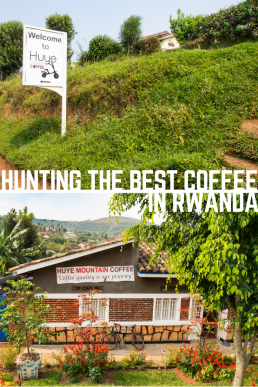
Visit Serengeti in March for Baby Animals and Predators in Action
Serengeti National Park is one of the best places on earth to witness the ancient drama of prey and predator. Serengeti’s predator concentration is high year-round, yet it multiplies when the migrating wildebeests and zebras are calving in March.
What to Expect From the Serengeti Safari in March
In March, the rolling grasslands of Serengeti gleam still in the colors of ochre. Occasional acacias dot the endless plains giving a harmonious rhythm to the sparse landscape. Wildlife is exceptionally easy to spot since grass remains short before the rains arrive.
Serengeti has the largest population of lions in Africa: more than 3000 lions are roaming inside the ecosystem. When the great migration arrives, lions binge. Wildebeests form almost a half of the food pyramid of African lions. Luckily for Serengeti lions, zebras are their second favorite catch. Whereas usually, game drive remains a game with no certain promises about the outcome, I can assure that you will see the world-renown Serengeti lions in March. The migrating and calving hooves make lions reckless and thus easy to find.
When visiting Serengeti in mid-March, we got goose bumps more than once while watching the inevitable cycle of nature. Big cats were chasing their prey and feasting on wildebeest at one spot, while a moment later we saw hyenas chopping bones loudly and fighting for their treasures. We learned to love hyenas and vultures, as they clean the kills finishing the scene. Besides tens of lions, we managed to see a couple of cheetahs and leopards on our game drives in Serengeti. Following a pregnant leopard at zero distance for several hundred meters to its nest was one of the highlights of our safari in Tanzania.
In March, you are guaranteed to see tons of baby animals in Serengeti, so be prepared for cuteness overload. We saw baby lions, elephants, warthogs, hyenas, jackals, baboons and monkeys, wildebeests, zebras, and many different antelope species.
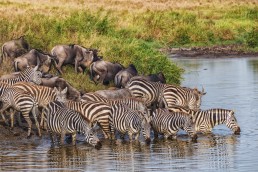
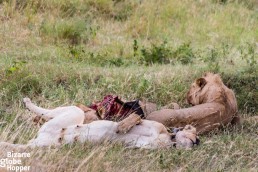
What Part of Serengeti to Visit in March?
The area of Serengeti spans from Tanzania to southwestern Kenya where it’s called Masai Mara National Park. Masai Mara tends to be emptier than Serengeti National Park during March because the heavy rains have already driven the migration cross the border to Tanzania in search of new pastures.
Adjacent Ngorongoro Conservation area, including Ngorongoro Crater, area also part of the Serengeti ecosystem. Whereas seasons affect wildlife viewing in the rest of Serengeti, in Ngorongoro Crater game drives are incredible year-round. As March is already low season, accommodation prices sink, and the crater is less crowded than usually. We visited Ngorongoro Conservation Area and the Serengeti National Park last March and felt blessed to see loads of animals while avoiding congestion.
Although it’s hard to predict the exact location of the migration, in March it’s easier than usually. Since the hooves are calving from February to March, they tend to stay in the most fertile area available: the plains below Ngorongoro Crater. Volcanic soil offers the most nutrient-rich grass for pregnant gnus and newborn calves. Predators follow the migration, so it’s recommendable to do the same!
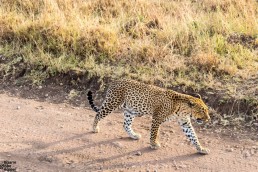
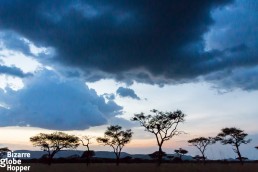
But How’s the Weather in March?
Some say that March marks the beginning of the peak rain season in Serengeti. It’s half true because the long rains tend to arrive in late-March. We stayed in Serengeti area from the beginning to the middle of March. During the time, we encountered only one shower during the night. That said, I cannot promise that it won’t rain in Serengeti during March. But even if the long rains arrive early, it seldom rains the whole day. Temperatures hover around pleasant 20–27 degrees in the Serengeti plains, dropping noticeably at higher altitudes. Sky tends to get cloud coverage toward to the end of March.
Personally, I think that any timing is right for a safari – you just have to be prepared, both mentally and gear-wise. During the rainy season, it’s usually harder to spot wildlife, since long grass steals a part of your vision and migrating hooves tend to split into smaller groups. But after the first rains, the scenery will be breathtaking, and the air feels fresh. The rains also bring magical afternoon thunderstorms above the endless plains offering drastic photo opportunities. No matter which season you visit Serengeti, you simply can’t get enough of spotting wildlife and admiring the landscape. The profusion of prey species makes Serengeti a haven for big cats and an unbeaten safari destination for you – year-round.
Have you visited Serengeti in March or during the rain season? Please share your experiences in the comments below!
Ombeni African Safaris hosted us on a 10-day safari through Serengeti and other national parks of Tanzania, but all the views presented here remain our own.
Pin this story!
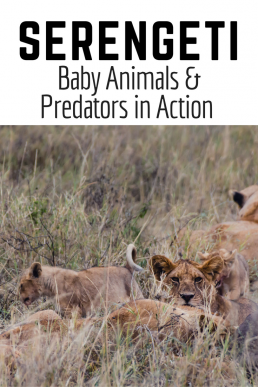
Soothing Visit to the Crater Lakes of Uganda
Fort Portal area in Western Uganda has one of the densest concentrations of crater lakes in the world. The photogenic explosion craters rhythm the rolling hills giving the landscape a pastoral flair. Some of the craters are flooded with unbelievably clear water; the others are vegetated and even cultivated. Our brief visit to the crater lake area was an utter bliss in between a tight safari schedule.
The crater lakes region lies in the western Uganda, in Albertine Rift Valley near Congolese border. Total of 86 crater lakes are paired with vegetated calderas and guarded by the mighty Virunga and Rwenzori mountain range. It is believed that these lakes were formed in extremely violent, volcanic explosions about 10 000 years ago. Most of the craters are now extinct, though some release the smell of sulphur. While also Lake Bunyonyi is considered as a crater lake, we’ll cover here only the smaller lakes pocketed around the town of Fort Portal. But another article about Lake Bunyonyi is also on its way!
Which Crater Lakes to Visit and Where to Stay?
The crater lake area is officially divided into lake clusters of Fort Portal, Kasenda-Ndali, Katwe-Kikorongo, and Bunyaruguru. Kasenda-Ndali area, about 30 kilometers south from Fort Portal, has the highest number of lakes. Pleasingly, it’s also the most easily accessible for tourists.
Accommodation preferences probably narrow down your choice of the crater lake. Options stretch from basic accommodation in nearby towns to communal campsites and luxury lodges with serene lake views. In general, the views are at their very best from the hills, not straight from the shores.
Our Pick: Ndali Lodge at Nyinambuga Crater Lake
I have to admit that our choice was made according to the impeccable views of delicately plush Ndali Lodge. We fell in love with the picturesque Nyinambuga crater lake based on Ndali’s glowing TripAdvisor reviews. And honestly I couldn’t have imagined more picturesque setting! The dreamy view from Ndali to Nyinambuga Crater Lake decorates deservingly Ugandan 20 000 Shilling note.
A winding road from Fort Portal passes three smaller craters before leading to the Ndali Lodge that rises dramatically on the top of Nyinambuga Crater Lake. Perched on a rim between vegetated explosion crater and Nyinambuga, Ndali offers unbeatable views to both directions. On a clear day, you can even see the distant wall of Rwenzori mountains. Witnessing a sunset from our porch behind the blue peaks is one of those moments that we’ll cherish the rest of our lives.
The roots of Ndali Lodge run deep: the estate served as a tea plantation already in the early 1900s. The candle-lit dining area and lounge have a homey, yet quaint British colonial feel. Breakfast view from the veranda is among the most breathtaking morning vistas we’ve ever had during our travels. Photos transmit only a part of the charm: there’s something so magical in the atmosphere that you just have to experience it yourself. Don’t skip a sundowner at Ndali Lodge, if you are around!
Hike Down to the Shore of a Crater Lake
Activities depend on where you stay, but you really cannot escape pretty forests with a dramatic backdrop of the crater lakes. Some viewpoints are accessible by road, but to really experience the distinctive surroundings, take a walk! Hills rise steeply from the shores promising a strenuous walk both ways. But you’ll be rewarded with tons of birds, butterflies, and playful monkeys.
Our walk down to Nyinambuga crater lake was accompanied by two adorable resident dogs from Ndali Lodge: Polly and Sybil. The exuberant fellows showed us the right path, playing with each other and chasing primates. We always miss our little dog while on the road, but Polly and Sybil eased our longing by greeting us in the morning and couching under our dinner table.
After a perspiring descent, a pleasant surprise awaited us on the shore: a dock with benches upon a placid lake. Chirping got so loud that we hardly heard our own voices and settled for just gazing the scenery. If you are into birding, the walk gets even more satisfying, since you can spot for example Ross’s turacos and Great blue turacos.
Due to high altitude (appr. 1400 meters), Nyinambuga and some of the other crater lakes are said to be bilharzia free. I wouldn’t risk it, though. Some recent studies have found a high rate of Schistosomiasis (bilharzia) in travelers who have only swum for a couple of minutes in the pristine waters. There are said to be also hippos lurking around. So don’t swim, just admire the beauty around you!
Visit Rural Villages and Vanilla Plantations
Tiny rural villages around the crater lakes remain untouched by tourism and modern way of living. Still these vestal hills are home to the vanilla plantations, which produce world-class black gold rivaling the premium Hawaiian and Balinese vanilla we have sampled before. Ugandan vanilla is a must-have souvenir, though expensive. We bought ours from Ndali Lodge since theirs is organic. Stop by in some of the villages just to buy a sugar cane or fruits – a good excuse to talk to locals and immortalize the pastoral landscapes. Some vanilla and tea plantations are also open for a visit.
Unwind Between Safaris or Take a Chimpanzee Trek
Crater lake area is a lovely home base for chimpanzee trekking if you’re planning to greet the primates of Kibale Forest National Park. We did our chimp trek in a less crowded forest of Kyumbura in Queen Elizabeth National Park. If your safari in Uganda covers Queen Elizabeth National Park, the crater lake area is almost on your route back to Kampala or towards Murchison Falls National Park. So take it easy for a day or two in the tranquil hideaway before the next long drive!
Have you visited the crater lakes of Uganda or similar explosion craters somewhere else in the world? Please share with us your experiences!
Our stay in the crater lake area was hosted by Ndali Lodge, and Mamaland Safaris toured us through the beautiful Uganda, but like always, all opinions remain our own.
Pin this story!
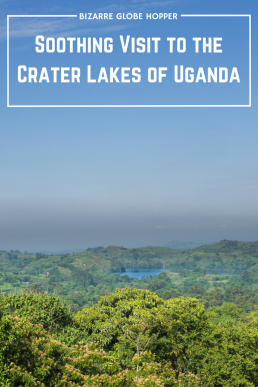
Sight of the Week: Naabi Hill Lookout in Serengeti
On arrival at the Serengeti National Park, don’t miss Naabi Hill lookout. A short hike upon a tree-covered, rocky hill offers an incredible panorama to the endless plains. If you look hard enough, you can spot wildebeests, zebras, gazelles, and even giraffes grazing in a distance. During the walk, you’ll get familiar with a unique ecosystem called kopjes with its distinctive flora and fauna.
If the great migration roams nearby, Naabi Hill trek is highly recommended. But it’s a lovely walk year-round since resident lizards together with colorful birds and butterflies will keep your eyes entertained. We had a lot of fun photobombing agama lizards, which lied on the scorching granite in great numbers. I made a mistake of sneaking too close and was soon reminded how quickly they can attack. We also saw some bashful Rock Hyraxes and mice.
Naabi Hill is visible on the horizon from far away, since it rises upon the otherwise flat grassland. You can see similar majestic, rocky outcrops also elsewhere in Serengeti, but Naabi Hill and the visitor center in Seronera are the only places where you are allowed to walk around. These kopjes have been created by erosion, which has slowly devoured the soft, volcanic rock from the ground exposing the ancient, metamorphic rock below. Blazing, African sunlight and harsh winds shape the surface continuously.
There are a lot of signs telling about the endemic fauna and flora. Some animal and plant species flourish only in kopjes and for the others, these rocky hills offer unbeatable vantage points and hiding places. Lions and cheetahs commonly hide their cubs in the kopjes – and Naabi Hill has a resident lioness!
Naabi Hill is located conveniently by the main gate of Serengeti and offers a welcome break from all the driving. So take a little hike while your guide is sorting out the entrance paperwork: it might take more than half an hour anyway since Naabi Gate is heavily trafficked. If you don’t feel like hiking, the benches near the gate offer interesting birding opportunities. With our limited skills, we recognized more than four species of birds. But someone told us that it’s possible to spot even 15 species in 15 minutes!
10 Reasons to Fall in Love with Nicaragua – And to Travel to Nicaragua in 2019!
Nicaragua has been one of the most hyped destinations in Central America for years. With the stabling security situation, you should definitely travel to Nicaragua in 2019 before everyone else is there! We listed ten highlights of Nicaragua to spirit you up and nudge those Nicaragua travel plans into action. How many reasons do you really need? Just book your tickets, Nicaragua is waiting!
1. Nicaragua’s Paradise Beaches with World-Class Snorkeling and Surfing
With two coastlines and authentic Caribbean islands, you have a problem choosing the best beach destination in Nicaragua. Off-the-beaten-path beach life is one of the reasons why Nicaragua stole our heart.
For snorkeling, go to the Corn Islands on the Caribbean side. For the surf, it’s the Pacific. Vibrant surf town San Juan de Nicaragua will keep you busy during the night, as well.
2. Imposing Volcanos for Hiking, Volcano-Boarding, and Photographing, and Easy Day Tours
Yearning for demanding multi-day hikes or easy access points to misty cloud forests and steaming craters? Nicaragua has them both.
Cloud forests can be found on the banks of Volcan Mombacho or Volcan Maderas. The island of Ometepe has even two cones to choose from, and in León, you can surf down from black-sanded Cerro Negro volcano.
The fuming peak of Masaya is conveniently accessible by car!
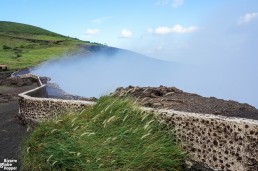
3. Virgin Jungles and Wild River Adventures in Rio Indio and Rio San Juan
Nicaragua has still undiscovered corners and mysterious jungles if you are willing to step out from the beaten path.
Visiting Reserva Biológica Indio-Maiź was indisputably the highlight of our Nicaraguan adventures. You can paddle deep down the old Indian River, called Rio Indio, or take a motorboat and still spend days getting deeper and deeper to the unknown. The more civilized adventure takes you through Rio San Juan in a public boat, all the way from the Caribbean to Lake Nicaragua.
Both rivers are teeming with crocodiles, alligators, iguanas, monkeys, turtles, and hundreds of birds. In Indio Maíz, you could see even manatees, sloths, jaguars, and pumas! Check out our tips on how to organize a trip to Indio Maíz!
4. Authentic Encounters with Indigenous Tribes
Nicaragua has seven groups of indigenous people, living at both coastlines. The Caribbean coast is home to the Miskitu and Rama, whereas the Pacific side and North accommodate Chorotega, Nahoa, Cacaopera, and Sutiaba.
We were lucky to spend a couple of days with the Rama: first touring San Juan de Nicaragua and then penetrating the virgin jungle with two Rama Indians to spend a night in their territory in Indio Maíz. The visit felt incredibly authentic: we were spending some quality time with two Rama families, who showed us their way of life. It felt like visiting old friends.
5. Crazy Nicaraguan Adrenaline Adventures
You probably foresee me listing surfing, riding, mountaineering, rock climbing, zip-lining, and rappelling.
Quite many have also already heard about Nicaragua’s very own adrenaline activity: volcano boarding. Would you climb on top of an active volcano just to slide down with a surfboard? It’s definitely crazy, and becoming very touristy, but still well worth the try.
Our favorite was Somoto Canyon Tour, dubbed ambitiously as “the best unknown adventure activity in Central America”. The Somoto canyon adventure is made of hiking, wading, swimming, boating, and some serious cliff jumping. The setting is by the notorious border of Honduras, well off the beaten path.
6. The Charm of the Past: Stunning Colonial Cities and Sleepy Rural Idylls
Where else could you choose from the picturesque colonial cities or rustic countryside?
The island of Ometepe transports you to the bygone era with ox-carts and real cowboys herding their cattle back from the lush slopes of the cloudy volcanoes.
Granada and León are competing among travelers for the title of Nicaragua’s most beautiful colonial city. We cast our vote for the crumbling charm of León.
7. World Renown Coffee and Cigars
It would be criminal to depart Nicaragua without some prime coffee beans and world-famous cigars! If your schedule allows, collect your treasures from the field: visit Estelí for the cigar factories and Jinotega area for the coffee beans.
8. Tasty Food and Beer
To add up: food and beer are more delicious than in neighboring countries and “the national rum” Flor de Cana is among the best we’ve tasted!
Even the boring staple dish of Central America, gallo pinto, tastes better in Nicaragua than in Costa Rica. Both national beers, Toña and Victoria, are better than the cheap local brews elsewhere in Central America. And now I’ve heard that they are brewing IPAs, wheat ales and even stouts in Nicaragua – I have to get back!
9. More Bang For the Buck
Being one of the cheapest countries in Central America, Nicaragua is easy on the wallet as well. Backpackers revel, but so do luxury-seekers, since even high-end facilities are affordable.
10. Classy Boutique Hotels
Last but not least: you can make the Nicaraguan adventures comfortably. If you can’t stand basic accommodation, it would mean stripping down some of the depth from the experience in Indio Maíz, but you’ll still be able to see most things we listed in our “4-week itinerary into the heart of Nicaragua”. The good news: you can comfortably day-trip to the main sights from your boutique hotel haven almost everywhere. Check out our list of the best boutique hotels in Nicaragua!
One More for the Road: How Nicaragua Jumped into Our Hearts
We fell in love with Nicaragua instantly, even before landing. After visiting Costa Rica and hearing that Nicaragua would offer the same things but in a more primitive package, we knew it was the place for us. There aren’t as much tourism related services as in Costa Rica, and infrastructure is still quite poor in remote parts (no roads), but that’s just a part of the charm. The minor inconveniences translate into real adventures and fewer tourists.
Our four-week adventure in Nicaragua was the best holiday in years, being maybe the most versatile trip we’ve ever done (competing only with our one month tours in Japan and Cambodia). I blame our itinerary, which covers the main highlights, but adds up also some bizarre detours. Check it out and let Nicaragua blow your mind!
If you’re already in love, join the confession and share your favorite things about Nicaragua in the comments below!
Pin this story!
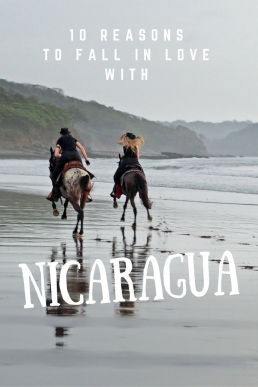
How Bungee Off the Victoria Falls Bridge Knocked Down My Fear of Heights
I’m standing on the Victoria Falls Bridge in a tight bungee harness, paralyzed from the fear, my hands spread out wide and feet already over the edge. I’m afraid of heights: every time I look down from any bridge, I start to sway and picture myself falling down. Now I’ve made my last walk with feet bonded tightly together to the edge of this massive bridge, and there’s no another way out besides the freefall.
Two men are standing behind me, and if I’m not jumping, they will push me down towards the raging rapids of Zambezi River, 110 meters below my feet. When the men start counting, I know that the end is near. Time lingers by slowly. “Five!” I breathe as deep as I can. “Four!” Is this it, am I going to die? “Three!” Gather yourself, keep your eyes on the horizon, don’t look down, or you lose yourself to the fear. “Two!” Concentrate! You can do this! Just remember to dive out as far as you can, so you’ll be safe, they said. “Bungee!” I concentrate my mind on the movement, jumping as far as I can, and free-fall headfirst towards the crocodile-infested Zambezi.
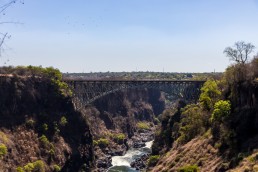
Confronting My Fears During the Bungee
The jumping phase felt rather manageable. I was so concerned with executing the bungee jump correctly that there was no room for fear in my mind. The crew had pointed out very clearly that a long jump prevents injuries, so I practiced the perfect leap in my mind and put all my cells in work to produce the life-saving bungee jump. Counting helped me to gather my strength in time. I usually count when feeling terrified, just to balance the emotions and feed the mind with routine instead of the destructive cycle of fearful thoughts. Counting reminds me of my meditation practice, instantly calming body’s stress reactions.
However, the free-fall felt awful again, probably because I had no means of controlling the situation anymore. I still wasn’t sure if I was going to make it. I felt the rush of the bungee, but couldn’t enjoy it. During a couple of seconds, I tried to take deep breaths, but the raging thoughts took over again. In a flash, I remembered the bungee accident from 2012, when the cord broke off here at the Victoria Falls Bridge. The bungee jumper crashed into the river; feet still hung together. Somehow that person managed to unfold the tangled bungee cord from the bottom of the river and swim to the shore avoiding crocodiles. I knew I couldn’t do the same.
Suddenly my bungee cord bounced forcefully, whisking me to the standing position, then upside-down again. I freaked up again, thinking that something should have gone wrong because the river seemed to be far away from my bounces. Deep breathing brought me back to the moment and accidentally I enjoyed the scenery. The mighty Zambezi was shimmering below my face, and I could see the exact rapid, where we had started our white water rafting trip the day before. It was surreal: I was hanging above the beautiful Zambezi Gorge that marks the border between Zambia and Zimbabwe, swinging from one country to another. When the bouncing got softer, I realized that I had survived the bungee, grinning widely. Conquering my fears felt overwhelming, though I wasn’t sure if I had enjoyed the bungee itself.
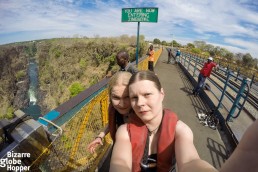
How Bungee Changed My Mindset Towards Heights
The Victoria Falls Bridge bungee changed something in me forever. Immediately after the bungee, I wasn’t that much terrified of heights anymore. Even after the adrenaline rush had faded, my mindset towards the heights was veered. I don’t imagine myself falling down while walking at the edge of the bridges, nor do I fear to stand on the edge anymore. I know that I could do bungee again though it might still not be enjoyable. I was surprised how I reveled walking in the structures of the Victoria Falls Bridge right after the jump. You can do that also on a separate “Historic Victoria Falls Bridge Tour” if you’re not into bungee. Those catwalks under the bridge were used in the construction back in 1904, so it’s a journey through hundred years to the era of Victorian engineering. You can really feel – and smell – the history of this great railway bridge while walking beneath it.
Is Victoria Falls Bridge Bungee Safe?
The last recorded bungee accident happened in 2012. The possibility of accidents is said to be one in every 50 000 bungee jumps. I felt safe all the time since the crew was very firm and attentive. They checked our harnesses and locks many times before the bungee, gorge swing, and slide. The crew also did an excellent job in leading everyone towards the bungee, without letting us give up. They chatted with us all the time keeping our minds busy, thus avoiding second thoughts.
Adrenaline junkies usually acknowledge the risks. In bungee, you might get leg injuries due to the bounces or for example hand injuries due to the wrong position. The usual restrictions apply: if you have health issues, such as heart problems, high blood pressure or back issues, you probably shouldn’t dream about the bungee. We both have back problems and were fine with the jump though the bounces gave us a mild pain. If you worry about accidents like me, it might soothe your mind to do a bungee above water. Though during the dry season, there won’t be enough water for a dive. Luckily the 2012 bungee accident happened during the rainy season, and it had poured just a day before.
How to Prepare for the Victoria Falls Bridge Bungee?
If you are afraid of heights, don’t start with the bungee at Victoria Falls Bridge. We took the “Big Air Experience” package, which included Gorge Slide, Gorge Swing and the Victoria Falls Bridge Bungee. Execute the lamest activity first to familiarize yourself with the heights. Gorge Slide is a zipline that takes you across the Zambezi Gorge from Zambia to Zimbabwe. The speed is only 25 km/h, so you have also time to enjoy the view. Sliding wasn’t scary to me since we’ve been zip-lining before.
As a bonus, you’ll also get the Gorge Swing, which is both thrilling and hilarious, but not at all terrifying after the bungee. We shared the fun and did it as a tandem jump, screaming and laughing like crazies. In the Gorge Swing, the free fall phase felt slower than in bungee since you just take a long step from the platform instead of jumping. That’s why the falling phase also felt more enjoyable and drastic. After the fall, you’re just swinging above the Zambezi Gorge in a sitting position with a plenty of time to admire the view. Gorge Swing was my absolute favorite.
Forget flip-flops and sandals unless you feel like bungee jumping barefoot. For most people, it is more comfortable to walk on the edge of the bridge with shoes on, since it won’t feel slippery. Listen to the instructions carefully and picture yourself leaping as far as you possibly can. It helped me to make a proper bungee jump, although my mind was raging at the exact moment. Remember to breathe, as it will soothe your system. Trust that everything will go right and enjoy the scenery!
The Victoria Falls Bungee is constantly voted among the best bungees in the world. Where else can you admire the World Heritage Site during your bungee jump while swinging from one country to another?
Are you afraid of heights like me? Have you done a bungee or would you dare to jump off the Victoria Falls Bridge? We would love to hear about your bungee experiences!
Our journey through Zambia was hosted by Zambian Traveller. Shearwater Victoria Falls gave us a discount on their Big Air Experience Package including Gorge Swing, Gorge Slide, and The Victoria Falls Bridge Bungee.
Pin this bungee adventure!
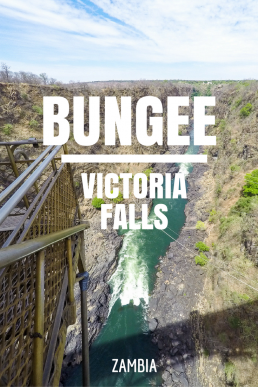
How to Save the Declining Lion Population of East Africa
Although big cats are easy to find in Serengeti, the lion populations are shrinking almost everywhere in Africa. Habitat loss aggravates the effects of the old culprits, trophy hunting and poaching. While Tanzania has still more lions than any other African country, the population has declined by 60% in two decades.
After two epic safaris in East Africa and one in Southern Africa, we feel the urge to share our concerns about lion conservation. Since we absolutely adore all the big cats, the recent studies and incidents have left us heartbroken. Our beloved Serengeti has long been the icon for lion conservation, but now its position is threatened.
The scientists are predicting that lion populations are cutting to half in just two decades. According to the recent study, the steep decline will happen in the West, Central and East Africa. Only in South Africa, the lion populations might grow. Some populations are doomed to be wiped out entirely. As lions are apex predators, the crash of populations will shake the entire ecosystem.
The lion count in Western and Central Africa is already as low as 900, whereas the total number in Eastern and Southern Africa is said to be around 19 000. The savannah of East Africa have been the most legendary spot for watching the big cats in their natural habitat. So what leads to these depressing estimations, and what in earth is happening in East Africa?
Trophy Hunting, Poaching and Retaliation Killings of Tanzania
Let’s face it: lion’s only predator is human. People are banishing lions from their habitats and killing them – for sport, money and retribution. East Africa’s growing human population poses increased risks to all wildlife, including lions. Agriculture, roads, and settlements narrow down wilderness bringing lions closer to farmers and herders. The same blames dwindle the natural prey, causing lion attacks on livestock and human reprisals on lions.
Tanzania is known as a land of conservation and famed national parks, yet it’s also the most hyped destination for sport hunters, dubbed as ”the jewel of African hunting”. Only South Africa rates higher in trophy hunting, but in South Africa majority of the hunted lions are bred in captivity. In Tanzania, the hunted lions roam free in the wilderness. The land reserved for sport hunting, 95 000 square miles, is five times greater than that of national parks and protected reserves. Some conservationists claim that hunting supports lion populations since the land would otherwise be used for farming or other purposes, which might hurt wildlife even more. Still in Tanzania, the trophy hunting is the primary reason for steep drops in lion populations outside protected reserves.
The aftermath of sport hunting weights even more than just the trophy lions. Hunters prefer the biggest trophies available, the dominant males. When an alpha male is killed, lions fight for dominance killing the cubs and females protecting them. Tanzania has lost so many dominant males during the recent years that the hunters are now killing maneless lions, which is an alarming sign for the whole business. Hunters are after the biggest trophies; if they go home with smaller ones, the proper trophy lions might not be available. Trophy hunting is said to be the prime reason for the drop in dominant male numbers.
Tanzania has lost 60 % of its elephants in just five years of ferocious poaching, mainly in the Selous area. Albeit lion poaching luckily isn’t that big, also the lions are threatened by the growing interest in Chinese medicines using lion claws and teeth. Some claim that the lion poaching has become larger in Tanzania during the recent years.
How Cecil the Lion is Changing Hunting for Trophies
When Cecil the Lion was lured outside of a national park to be killed in last July, the great masses uproared. And fortunately, the debate around Cecil’s death aroused some good news.
France showed the way by banning the lion trophies in last November. Obama administration followed, setting lions under Endangered Species Act in December. From now on, Central and West African lions are classified as endangered, whereas Southern and East African lions are listed as threatened. Sadly, trophies from South and East Africa can still be imported to States, if the killings were legal. Since trophy hunting happens mainly in Southern and Eastern Africa, the classifications should have been more strict. In my opinion, the act seems disturbingly cosmetic, because the protected lion populations in West and Central Africa are already nearly extinct.
Also,the UK has renounced to ban trophies if the hunting industry doesn’t mend its ways. So the situation is getting a slightly better, though not exactly optimal. At least, the kill of Cecil startled the conversation. Now is time to act.
Would Fencing be a Solution?
There has been a lot of discussion about fencing the national parks, and the both parties have strong arguments. Big cats are threatening humans, killing cattle and pets; while elephants are trampling crops. When cattle enter protected lands, the habitat for wildlife narrows down. Still fences would disrupt the natural flow of animals shutting down ancient wildlife corridors. The latest natural solution is a ”bee fence” that is tested near Ngorongoro area. I’m hoping these kinds of innovations would ease the human-wildlife conflict and eliminate the need for physical fences.
Preventing Lion-Human Conflicts
African Wildlife Foundation’s clever initiative in Maasai Steppe Heartland aims to prevent lion-human conflicts, thus reducing lion kills. The area is home to the national parks of Tarangire and Lake Manyara along with the cluster of Maasai pastoralist communities. According to its name, ”Maasai Steppe Predator-Proof Bomas” helps local herders to build enclosures (bomas), where livestock remain protected from the predators at night. The livestock kills have been reduced tremendously, which has brought down the retaliation kills of lions.
How You Can Support the East-African Lions
The big question is, how each and every one of us could help the lion population of East Africa? First of all, raising awareness and showing your side helps. If you are going to a safari, choose a safari company who is openly fighting against poaching. There are also a lot of organisations doing miracles, such as African Wildlife Foundation, Serengeti Watch, and African Wildlife Trust. They happily accept donations, though there are also other ways of supporting their work, and the membership of Serengeti Watch is free.
Pin this story!
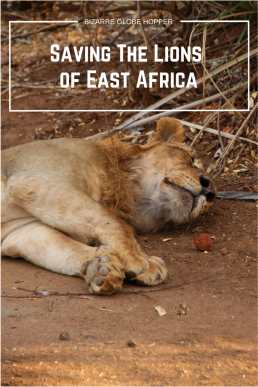
How to Find the Best Wildlife Sightings in Serengeti National Park
Finding the best wildlife sightings in the vast plains of Serengeti can be tricky even for the experienced guides. Learn when and where to see the famous Serengeti lions and other predators, where to find the great migration during and after the peak season, and how to avoid the crowds. Make your safari in Serengeti truly once-in-a-lifetime experience with our wildlife spotting tips!
Serengeti National Park encapsulates the African safari experience. More than a million wildebeest roam through the endless plains each year following the magical beat of nature while the whole Big Five runs close. Read on to get the box seat from this ultimate wildlife theater instead of fighting for the best sightings with the masses!
How Big is Serengeti National Park and Why Does It Matter?
Serengeti’s merits are impressive: it’s listed as a UNESCO World Heritage Site and the 7th wonder of the world.
Serengeti is hands down the most popular national park in Tanzania and constantly stays in the top 5 most visited parks in Africa.
The hype means that more than 300 000 visitors share the wildlife sightings each year. During the high-season, Serengeti gets crowded. That said, its boundaries are vast.
Serengeti National Park is six times bigger than Kenya’s Masai Mara and easily larger than some European countries. The name comes from Maasai word “siringet” meaning “the place where the land runs on forever”. Luckily, Serengeti is big enough to avoid crowds if you are willing to step aside from the beaten path.
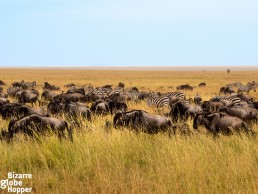
Great Migration Marks the Peak Season in Serengeti and Masai Mara
Serengeti is famous for the great migration, an incredible show where 1,3 million wildebeests together with 200 000 zebras and gazelles drum over the endless plains in the search of fresh grass. The sheer number of hooves makes it a play of survival where everyone tries to avoid getting stamped or captured by ravenous predators. Serengeti’s great migration is the largest mammal migration system in the world – and one of the last intact migration systems altogether.
The most iconic – and photographed – moment is when the disorganized pack of hooves crosses the Mara River teeming with enormous Nile crocodiles. If you urge to see that, the choices run short: head to Kogatende area in the northern Serengeti. Typically the best timing is from late-July to mid-October, but as the last years have shown, nature is unpredictable.
Be prepared to take part in the human migration during August and September, when also prices are at their peak. Choose your tour operator wisely and prefer private camps. A good guide can save you from the biggest crowds.
The Best Timing for Leopard, Cheetah, and Lion Sightings in Serengeti National Park
Whereas the great migration is seasonal, you can spot the world-famous Serengeti lions all year round. Watching lions feasting on a hard-earned kill is a sight to remember.
The best timing to see predators in action in Serengeti runs from February to March since that is the prime calving season for hoofed animals. The big cats follow the migration: during February and March they roam in the plains below Ngorongoro Crater. Read this article to learn why you should visit Serengeti in March.
How to Follow the Great Migration in Serengeti During the Peak and Off-Season
At the time of the great river crossings, Serengeti overflows with tourists. The good news is that the migration is on the move inside the boundaries of Serengeti year-round.
The location of the great migration cannot be firmly stated, although there are predictions. But don’t count totally on those detailed online maps when you make the bookings, because the schedule has been varying during the last years. Your best bet is a good tour operator who is willing to drive as far as needed to track down the migration and even change accommodation bookings on the fly if needed.
Where to Find Serengeti’s Great Migration in January, February, and March
From January to March the wildebeests are calving in the volcanic plains below Ngorongoro Crater, which offer the most nutritious grass for pregnant gnus and newborn calves. It’s the timing that you can usually count on since those fertile plains are the favorite spot for hooves – only rains can chase them away. Approximately 400 000 wildebeest babies are born between January and mid-March making it an exciting time to visit.
Where to Find Serengeti’s Great Migration in April, May, and June
Towards the end of March, the long rains begin, meaning regular showers until the end of May. Some roads become impassable, and the long grass disturbs wildlife sightings in Serengeti. In April, the migrating hooves split: some continue their journey west almost all the way to Lake Victoria while others turn already north through Seronera.
During June, the wildebeest herds can usually be found near Grumeti River in the western horn of the park.
The Peak Season: Serengeti’s Great Migration Reaches Mara River in July
By early July the first hordes of zebras reach the northern Serengeti, to be followed by wildebeests during the rest of the month. If there are enough grass and water, the migration spreads all the way from Seronera to Mara River.
During dry years wildebeests congregate near the river earlier. The migration stays typically in the northern Serengeti and Masai Mara until mid-October or November when the harsh rains chase the animals southwards once again.
Go Off-Season or Off-the-Beaten-Path
Safari in Serengeti should be “the trip of a lifetime” during which you can see more wildlife than anywhere else in the world.
Plan your safari carefully to tune your visit in Serengeti into a private nature document instead of following a line of other jeeps to the great kills. Whereas in South Africa, for example, you can visit private reserves of the Greater Kruger National Park (such as amazing Balule Nature Reserve) instead of Kruger National Park to beat the crowds, in Serengeti you must be more clever.
I would recommend visiting Serengeti during shoulder season to avoid to masses – unless you definitely want to witness the great river crossings. Since Serengeti National Park is huge, you can find private corners also during peak season, if your safari company is willing to drive off-the-beaten-path and you have enough time for the detours.
We really enjoyed our visit to Serengeti in mid-March and didn’t encounter any rainy days. It’s a beautiful time to visit since the plains are full of baby animals, and short grass allows good sightings. The calving season guarantees that lions, hyenas, and even cheetahs are easy to spot. If you need any assistance in planning a safari in Serengeti, please don’t hesitate to contact us!
*Disclaimer: Ombeni African Safaris hosted us on a 10-day safari through Serengeti and other national parks of Tanzania but all the views presented here remain our own.
Read More African Adventures:
Pin this story!
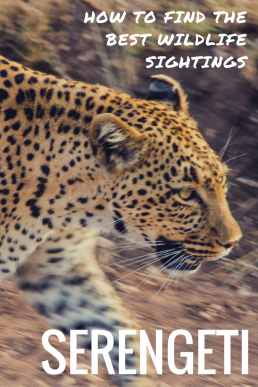
Tracking Rhinos on Foot in Uganda
Rhinos were violently demised from Uganda during Idi Amin’s brute regime and the following chaotic years. Nevertheless, it’s still possible to spot these gray giants grazing among the vast savannah. Ziwa Rhino Sanctuary has championed to re-introduce the extinct southern white rhino back to Uganda. Heated with the tragic history, fear, and excitement, we followed a ranger on foot to track down our first white rhinos.
“Can you climb trees?” our ranger asked for starters. I nodded laughing, yet a bit uncertain whether he was bantering. “White rhinos are not aggressive by nature. But if they feel threatened, they can attack”, he emphasized gravely and continued, “Make sure not to run when a rhino is approaching. If you cannot run faster than 45 km/h, the rhino will win.” Then the ranger smiled widely and started to pour his love for rhinos on us. Soon the excitement became too much to handle, and we hopped in a jeep to track down the nearest rhino.
Getting into the Spirit of Ziwa Rhino Sanctuary
We had arrived at Ziwa Rhino Sanctuary the day before, not sure what to expect. After driving through the pitch-black savannah all the way from Kampala, we were cheerfully received as the only guests. An armed guard escorted us to an open-air restaurant since a rhino was hanging out near our cabin and it wasn’t yet safe to go there. A couple of dimly lit lanterns and a thick curtain of insects separated us from the wild while we dined in the dark. In the next morning, we woke up to the chirping of exotic birds. Peeking through the window made it clear: the place looked like a sanctuary, too.
Ziwa Rhino Sanctuary is the only place in Uganda where rhinos live in their natural habitat. Under 24/7 surveillance of armed guards, totally 16 southern white rhinos are munching their way through 70 square meters’ private land, separated from the surrounding bush with a 2-meter electric fence. The southern white rhinoceros is the most widespread rhino species, yet it was nearly extinct already in the early 20th century, with only 20 individuals living in one South African Reserve. By 1982 savage poaching had wiped out both black and white rhinos from Uganda.
Tracking Rhinos on Foot
Heavy-hearted thoughts escorted our jeep through the grassy mud paths until we suddenly stopped beside a pile of rhino poo. These magnificent creatures made an instant good impression on us as they always use the same spot as their toilet. This was the first trace of nearby rhinos, meaning farewell to our jeep.
Next, the ranger pointed out fresh footprints and a proper kind of bush where rhinos could hide from direct sunlight. Off we rambled through scrubland, trying to find more tracks ourselves. Just when we were starting to feel like ancient hunter-gatherers, the bushes revealed a fellow ranger grinning at us, holding a radio phone in his hand. Of course, our ranger knew exactly where the rhinos were because they have around-the-clock guards.
A slight letdown was soon forgotten when our ranger whispered that we could slowly walk towards two rhinos that were still hiding from our sight. “For your own safety, you must follow the tracking rules and my commands at all times. Rhinos are wild animals, and although this is their breeding area, they are kept here as wild animals,” he reminded us.
Observing the Rhinos in Their Natural Habitat
The first glance of the wrinkled-skinned giants felt surreal, although some leafy branches were covering most of our field of view. The rhinos were still about 50 meters from us, behind verdant bushes. Morning sun speckled the ground around us; there was something serene in that very moment. We had seen black rhinos in Tanzania, but it was completely different to observe them from the comfort of a jeep. Now we were in the wilderness with the rhinos, with only two rangers as our protection. If the rhinos would have chosen to harm us, they could have easily done so. But they were just swinging their heads back and forth upon the grass, not minding about our presence.
We were photobombing the rhinos desperately, most of the time against the sun and from too far a distance for our lenses, because we thought that this was it. The ranger waited patiently, secretly laughing I bet, before telling that we could proceed closer. Waiting for the permission to move, we followed his steps cautiously. For around half an hour, we circled the rhinos, watching them spellbound – from different angles, near and further, through bushes and without any privacy screen. Occasionally we were just 10 meters from them. I still couldn’t believe that we were walking with the rhinos!
The rhinos were doing what the rhinos do: mostly eating. An adult Southern white rhino weights about 2-3 tons and eats 150 kilograms of grass each day. The massive need of food means that the rhinos spend most of their waking time eating. They don’t have time to sleep during the night, either. Only the scorching heat forces them to recede for a beauty nap in the shade of the bushes.
While monitoring the rhinos, the ranger kept us well informed about their habits and characteristics. We were observing a 15-year old female called Bella and her 1-year old calf, Luna. Bella belongs to the first group of rhinos that Uganda received after the extinction, donated by EU. At the time of our, visit Bella was already pregnant, though the current calf was still whining for milk with funny sounds. White rhinos give birth every two or three years; the calf remains with her mother until the next baby is born.
From the distance, we couldn’t see how these white rhinos would differ from the black rhinos that we had seen in Tanzania. Both white and black rhinos have two horns on their snout. There’s no actual color difference either; instead, you can identify the subspecies by looking at their mouth. In fact, “white” originates from a misspelling of “wide” that refers to the wide lip of the white rhino. Black rhinos have smaller, hooked lips, which allow them to grab tree branches. The head of the white rhino is so heavy that it can’t lift it to eat from the trees, but the wide mouth eases grazing. Thus the formal name square-lipped rhinoceros would be both correct and descriptive appellation to white rhino.
An hour flew by quickly – maybe because we felt so thrilled, or because the company was so entertaining. After the well-spent quality time with the white rhinos, our jocular ranger asked, if we knew where our jeep was. It was a quick reminder of how easily you get disoriented in the bush. Luckily he was kind enough to escort us back, though.
“New White Hope” Heals the Tragic History of Ugandan Rhinos
Uganda was once the only East African country with the both African rhino species: black and white. Whereas rhinos were hunted already during the British colonial era, Idi Amin’s fierce regime led the way to their complete extinction in 1983. When Idi Amin came to power in 1971, Uganda had still 300 black and 100 white rhinos. Three years after his overthrow, both species had died out.
After the extinction, six white rhinos were brought back to Uganda during 2005 and 2006, in the hope of creating a new generation. Of course, the rhinos weren’t roaming freely around the national parks, but well guarded inside the boundaries of Ziwa Rhino Sanctuary. After four years of nurturing, the first calf was born. Heart-breakingly, it was a stillborn. The next year brought finally a healthy baby, the very first rhinoceros born in Uganda in almost 30 years. That calf was aptly named Obama, since its mother hails from the States and father from Kenya. Thanks to felicitous mating, the Ziwa Rhino Sanctuary just celebrated its tenth baby rhino. All the females are also happily pregnant, so there should be more baby showers on the way.
Ziwa Rhino Sanctuary endeavors to reintroduce rhinos into Uganda’s National Parks. It’s an ambitious goal, requiring both successful breeding and the support of locals. Poaching is still the worst enemy of their work. Changing mindsets might be even harder than giving the rhinos round the clock protection. However, through education and community uplifting projects Ziwa Rhino Sanctuary is already on its way to winning the hearts of the surrounding communities.
Visiting Ziwa Rhino Sanctuary
Ziwa Rhino Sanctuary lies in Nakasongola district, about 180 kilometers north from Kampala. If you’d like to track the rhinos, the best timing is either early morning or late afternoon. When it’s hot, rhinos prefer to hide in the bushes. Reserve at least 2 hours for the tracking activity and some extra time for hanging around in the sanctuary. To get there you should have your own wheels, which are also well needed to get near the rhinos in the 7000 ha sanctuary. A car with a driver can also be rented from Rhino Uganda Fund. The Rhino tracking costs 40$ per person and vehicle rental 25$ per group.
Support the Ugandan Rhinos
The most entertaining way to support Ugandan rhinos is to visit Ziwa Rhino Sanctuary and make a donation on the spot. Protecting the rhinos 24/7 requires 80 well-trained guards and rangers, for example. The annual costs of Ziwa Rhino Sanctuary are around 500 000 $.
Rhino Fund Uganda is an NGO relying mainly on donations and sponsors. They are in a desperate need of new vehicles and equipment. The rhinos tend to thank for their protection by tossing around the guards’ bikes: we saw concrete evidence of this practice. If you’d like to support the rhino conservation in Uganda, go rhino tracking in Ziwa Rhino Sanctuary or please consider an online donation for Rhino Fund Uganda.
*Disclaimer: Our safari and rhino tracking in Uganda was hosted by Mamaland Safaris, but all the opinions and views expressed here are totally our own.
Pin this story!
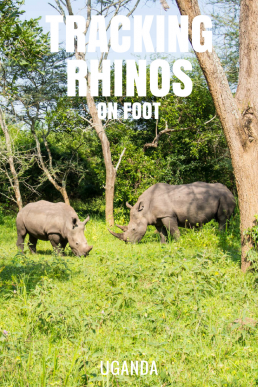
Sunset Dinner Upon the Roofs of Stone Town, Zanzibar
I can’t imagine the better way to enjoy a sunset over the fabled Stone Town than from the rooftop restaurant of Emerson Spice. The beautifully ornated Swahili mansion has its roots deep in the history of Zanzibar. After climbing hundreds of steep, wooden steps, you’ll be rewarded with one of the best sunset views in the city.
The Emerson Spice lies in the middle of Stone Town, the maze of crumbling alleyways. So as an added bonus you will be dining inside the Unesco World Heritage Site. The history lingers inside the house as well: the very same building has hosted for example Mwenyi Mkuu, the last Swahili ruler of Zanzibar and the richest man in East Africa called Tharia Topan. Excavations have also showcased some evidence of the first photographic studio of Zanzibar.
The 360 degrees’ panorama over the roofs of Stone Town, all the way to the enigmatic Indian Ocean, is what really screams for a romantic night out. From Emerson Spice’s rooftop restaurant you can admire the Stone Town’s blend of cultural heritage spotting a cathedral, mosque and Hindu temple at the same glance.
Special 5-course degustation menu uses traditional ingredients in creative combinations. Since space is limited, book your table well in advance. It pays to arrive early enough to get a cocktail in your hand before the yellow orb begins to turn red and starts its sink behind the chaotic skyline of Stone Town.
Pin This Story!
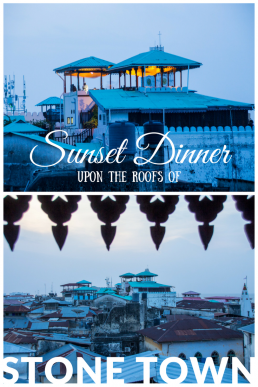
Our sunset dinner and stay in Stone Town was hosted by Emerson Spice, but all the opinions remain our own.
How I Fell in Love With Gili Islands, Indonesia
Gili Islands spoiled me in so many ways that after visiting several renowned paradise islands, I still haven’t found their rival. It’s all about an ideal mix of laid-back feeling, stunning underwater world, and dreamy sunset views from the sleepy beachside berugas. It wasn’t love at first sight, though.
Paradise Happened – With Small Afflictions
We came from a lush city of Ubud, which treated us with amazing, but affordable meals and distinctively Balinese atmosphere. Sure I was stunned to see just the right tone of turquoise sea against powdery white sand, but at first, Gili Trawangan felt like a backpacker hell with drugs, hawkers and over-priced food and drinks. You know that feeling of betrayal on arrival when you face reality instead of those picture-perfect paradise island dreams that you’ve been cherishing beforehand?
We took a speedboat from Padang Bai (Bali) to Gili Trawangan. The journey lasted around 2,5 hours, as our boat was one of the quickest. Because sea might be quite rough and boats do sink time to time, it’s wise to choose a reputable company. I felt a bit nauseated like I quite often do in a rough sea, but gorgeous views of Bali’s Mt Agung and Mt Batur over misty, green hills compensated my agony. When the three Gilis came into the horizon, each islet had funny little clouds above them. Boats dock offshore, so we dipped into knee-deep water – what a perfect way to enter island life! I was grinning happily already.
Our first night in Trawangan was filled with minor disappointments. The food was bland and expensive by Balinese standards, the “town” itself wasn’t a beauty nor did our hotel match up to those we had in Bali. Nevertheless, before the night had fallen, I was already fascinated by the simple pleasures of island life. I learned to love Trawangan’s backpacker vibe with a myriad of beach bars to choose from, although we are not party people. However, more serene Gili Meno suited our taste even better.
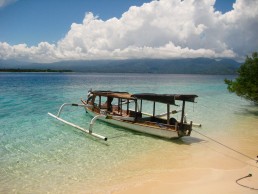
Where to Stay in Gili Trawangan and Gili Meno
Whereas Meno indeed felt like a quiet retreat like it’s advertised, introducing Gili Trawangan as a party island might be one-sided, since the western part of the island remains still uncrowded. Main drag, where also boats dock, has a cluster of noisy bars and most of the hotels. We stayed in Scallywags Resort, which is slightly south from the action. We liked the hotel in general, but if ever returning, I would choose some northwestern beach hotel. The area is more tranquil and filled with slightly more upscale beach bars, though it’s still a short walk away from the main drag.
“Meno” happens to mean action in our odd language called Finnish, but this small islet is the total opposite. With solely 300 residents (Gili T’s number being about 1000) even this 1 km x 2 km stretch of land might feel empty. Staying close to the main drag is a good option as there won’t be any loud music or other disturbance – and you don’t have to cross the island to get a dinner or to see a few people. We chose to stay just beside the harbor in Villa Nautilus, which was the most upscale option by then. Nowadays I would shop around.
For us Trawangan meant social life with an old friend we met there, watching sunsets in nice lounge bars by the ocean, and eating out in several international restaurants. On the other hand, our days in Meno were even more laid-back. We woke up, when the roosters decided, drank coconuts for breakfast, snorkeled all day long, and walked back home under the perfectly starry sky after sumptuous dinners at a beach shack.
Finding the Best Snorkeling Spots Around Gili Islands
Water is so clear and pristine that snorkeling in Gilis is gorgeous right from the shore, if you know the best spots. However, snorkeling trip will take you to the real treasures. Since currents are strong, it’s not advisable to swim that far.
We tried Trawangan’s best off the beach spots: one a bit north from the harbor (at the main beach) and second on the northeast coast (ask locals the exact places). In Meno, snorkeling was great just outside our hotel (Villa Nautilus) and to the left from it (at the main beach).
You can expect to spot several sea turtles, beautiful corals and myriads of colorful fish. In general Gili Meno offers the best reefs. We saw the most stunning corals while touring Gili Meno with a tiny boat and guide. Underwater world was a stunner: it really felt like being on acid. I haven’t encountered that clear water yet anywhere: not in Caribbean, Mexico, Nicaragua or Thailand to name a few of my later disappointments. We visited at least the sites called Meno Wall, Meno Slope and Bounty Wreck.
For us Meno Slope was the best place for seeing different species of turtles – and swimming with them. I also remember swimming above huge, colorful round table corals just before we reached a derelict boat, which was teeming with reef life. Our guide Opin told us that he was previously working in now abandoned Bounty Resort, whose former boat it was. One morning they just didn’t see the boat, and found it sunken. Now it’s growing soft coral, and when Opin free dived through the wreck, schools of different sized fish puffed into my eyes. We also stopped to see a coral named as Christmas Tree. I’m not good in fish or coral names, but I do remember playing with a globefish as well.
Just a bit further out you could spot mantas and sharks, so longer snorkeling trip will be well worth it, if you have the time and energy. We were happy with this short introduction and trained our newly found turtle spotting skills right off the shore with good results. Masks and fins can be rented from beach shacks, but quality isn’t great, so if you’re picky like us, bring your own gear.
Horseback Riding and Cycling Around Gili Islands
I strongly recommend venturing into inland to see a different side of the Gili Islands – something to deepen your experience of these small island communities. We rambled around to see how locals live in their modest shacks. One mother picked louses from her kids, another sorted out mushrooms in her backyard beruga, kids ran around, and toothless old men sitting outside their houses waved to us.
On Gili Trawangan we rented bicycles and circled the islet at a slow pace, stopping to snap photos, grab a beer and adore small turtles at the hatchery. On Gili Meno we were tempted to rent horses and asked from a cidamo driver if he’d knew any horses suitable for riding. Well, those weren’t the best ponies we’ve ridden on our travels, but luckily not malnourished either. Horses offered an easier means of touring the island in a scorching sun: we saw the swamp, ride past abandoned, eerie looking Bounty Resort and got exuberantly friendly greetings from locals.
Where to Grab Sunset Drinks
At Gili Trawangan’s northern stretch there are several nice lounge bars on the sand, which have happy hours around sunset and just after it. In general, northern end of the main street will be quieter than around the jetty. Rent a bicycle and take at least one sundowner at the sunset point (at the southern tip of Gili Trawangan), where people gather every night to watch the sun drop behind the volcanos of Lombok. There are also a few bars on the sand with loungers and occasional bonfires.
In Gili Meno any beach bar at the main drag will do; all of them have lovely berugas and the view is the same. If you are staying in north, Sunset Gecko has berugas by the shore.
Foodie Scene on Gili Trawangan and Meno
Neither of the islands is a foodie’s paradise, but from Gili Trawangan, you’ll find the international fare, whereas Gili Meno has only small beachfront cafés serving simple local dishes – and for some odd reason wood-fired pizzas. If you stay a number of nights, you’ll get bored with the selection. We dined out four nights in a row, from which three nights in Ya Ya Warung – I just can’t recommend them highly enough. Food is ridiculously cheap and tasty, so we were tempted to order almost the whole menu one night (I remember ordering at least six main dishes for three of us). Ya Ya is as local as it gets: a simple shack on the beach a bit north of the jetty. You’ll eat sand between toes, while listening locals playing reggae classics with a guitar, singing, laughing and smoking pot.
After trying several “real” restaurants on Gili Trawangan, we finally found our way to the food stalls of the main square. This backpacker favorite offers the cheapest food around, so we were a little suspicious at first but were happy to find out that the quality is actually great. A bunch of local fishers is selling their catch of the day and grilling it before your eyes. Even carnivores have many local dishes to choose from, like nasi goreng (fried rice), fried chicken, chicken satay, etc. We just love street food, since it’s usually more tasty and original than the restaurant fare and you can eat with locals – at least give it a try.
Karma Kayak on the northern side of Gili Trawangan offers mouth-watering tapas with an Indonesian twist – a definite must. Their location is good for snorkeling if waves aren’t too big, and the beach bar has a lovely setting for lazing around few hours. It was where we ate the best chicken satay of our trip: the sauce was perfectly sour ‘n’ smooth, chicken correctly coal fired.
Scallywags Resort offers organic smoothies and the best breakfast we encountered in Indonesia. Against it, their dinner was a disappointment for us (and we gave them even a second chance): food was mediocre and flavorless at it’s best.
Not to Miss on Gili Islands
- a sundowner at Gili Trawangan’s Sunset Point (you can bring your own bottle as well)
- a snorkeling trip (or scuba diving, if you have a license, Gili Islands also have a good freediving scene)
- cycling or horseback riding around the Gilis
- visiting the inland to see how locals live
- Gili Trawangan’s turtle sanctuary
- sumptuous breakfast at Scallywags at Gili Trawangan or Gili Air (the best we had in Indonesia, banana pancakes are to die for)
- local dinner at Ya Ya’s on Gili Meno and/or food market on Gili Trawangan
Pin this story!
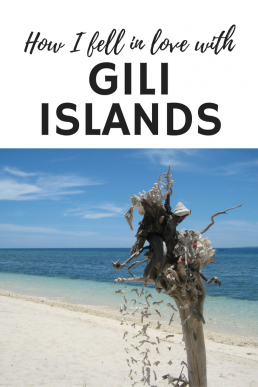
Lose Yourself in the Narrow Alleys and Quirky Sights of Stone Town, Zanzibar
Zanzibar’s signature blend of exotic spices, vibrant colors and the mix of cultures is omnipresent in Stone Town. It’s way too easy to get lost in the sensory overload and idle away hours navigating the crumbling alleyways of Stone Town. You either love it or hate it, but one thing is certain: Stone Town takes over you.
Melting Pot of Cultures and Religions
Stone Town is the old town of Zanzibar, an ancient trading post and bustling heart that still gives the whole island its peculiar beat. Only in Stone Town, it’s possible to see a Hindu temple, church and several mosques at the same glimpse, and even doors merge in the different traditions. If you love to photograph doors as much as we do, take part in our door hunting in Stone Town.
In its heyday, Zanzibar was a stopover for ships bound to Far East and back. History is rich with exotic scents, gold, and divine textiles, but it’s also dark. Two gloomy secrets behind the blossoming economy of Zanzibar have been slave and ivory trade. Unfortunately, there are still traces of the latter.
History of Stone Town is rich with exotic scents, gold, and divine textiles, but it’s also dark. Two gloomy secrets behind Zanzibar’s blossoming economy have been ivory and slave trades.
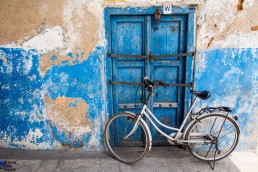
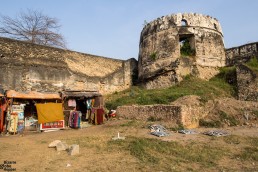
Let the Dichotomy of Stone Town Bewitch You
Stone Town is not a paradise for all. But if you know what to expect, you can fall in love unconditionally. Nevertheless, it might be hard to escape the negative sides of this chaotic labyrinth of dingy alleyways. The whole old town is labeled as the UNESCO Heritage site, but the majority of the buildings are decaying fast. Stone Town is noisy, pushy, and smelly. But at the same time, Stone Town can be enchanting and inspiring, if you give it a chance.
In Stone Town everything is two-parted. Alluring fragrances beckon to narrow alleys, where they become stinky smells of sewage and rotting garbage. During the rainy season, the charming alleyways swell and rats take over. Hotels shut down for April and May to be opened just before summer season in June.
Stone Town is subtle but ruthless. Architecture merges Islamic, Persian, Indian, and Swahili traditions, stealing just the best parts. Prayer calls and honking are blended with constant shouting, as neighbors change their gossip from the wooden balconies. The coral-stoned, ornamental facades tell stories of prosperous merchants and those of the slave trade. Once fancy mansions have eroded, though some are renovated into quaint boutique hotels.
Stone Town is also extremely touristic meaning endless rows of curiosity shops. In the old town, it’s hard to avoid herds during the high season. As a positive side, remarkable cafés and restaurants abound, and there are enough quirky sights to keep you busy for a couple of days.
While getting lost in the winding alleys of Stone Town, I swirled from the aversion to admiration but ended up loving the crumbled charm of this chaotic city. The reality behind the postcard views makes Stone Town even more captivating, in a way.
Stone Town is subtle but ruthless. Architecture merges Islamic, Persian, Indian, and Swahili traditions, stealing just the best parts. Prayer calls and honking are blended with constant shouting, as neighbors change their gossip from the wooden balconies. The coral-stoned, ornamental facades tell stories of prosperous merchants and those of the slave trade.
Step From the Spice Market to the Biggest Slave Market of Zanzibar
Stone Town’s bustling spice and food market serves as a hub where people around Zanzibar come to sell and buy things they can’t find in their neighborhood. For tourists, Darajani market offers an insight into local life. Myriads of exotic fish showcase the roots of these lands: just a couple of hundred years ago Stone Town was a just simple fishing village. At Darajani market you can find everything from spices, fruits, meat and other staples to electronics, cooking utensils and clothes. It’s fun to peek around corners, but don’t expect to find premium spices or authentic goods: most fabrics, shoes, and merchandise are imported from India, China, or the Middle East.
The next sight of Stone Town lurks conveniently almost around the corner. On the site of the Zanzibar’s largest slave market stands an Anglican cathedral, Church of Christ. Zanzibar was once the largest port in the Indian Ocean for Arab slave trade. Slave hunters tracked down their victims from the areas nowadays known as Western Tanzania and the Democratic Republic of the Congo and shipped them to Zanzibar, where slaves were sold to plantations or shipped forward to the Middle East and India. There’s not much left from the dark history, though. The notorious whipping post is replaced with an altar, but two slave chambers can be visited in their original state in the basement of the nearby hostel. You must pay an entrance fee to visit the whole slave market area, including the slave chambers.
After some deep thoughts, it’s time to cheer up again. While walking towards the seafront, the perfectly turquoise ocean peeps out through coral faced mansions and lush Forodhani Gardens, putting a finishing stroke to the postcard perfect view. Though the history is dark, Zanzibar has left its mark also as an anti-slavery stronghold. This is where for example Dr. Livingstone led his campaign.
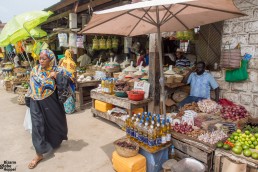
Stone Town’s Dr. Livingstone and Freddie Mercury Sights
Dr. Livingstone made Zanzibar his last home base. He lived on the outskirts of the city, in a mansion that hosted also other missionaries and explorers at the time. Zanzibar was the starting point of Livingstone’s last expedition to the source of Nile. The building, later aptly named Livingstone House, is now the headquarters of Zanzibar Tourism Corporation. Livingstone never made it to the source of Nile, but died Zambia. His heart was buried under a tree on the spot where he died. It’s said that the cross hanging in the Anglican Cathedral has the wood from that particular tree.
Since you are visiting the birthplace of flamboyant Freddie Mercury, pay your respects and take a picture of his childhood home. That’s all you can do at the moment since there’s no museum, just a hostel that was going through renovations at the time of our visit. You probably can’t avoid pushy street sellers offering Queen CDs; there are even Freddie Mercury walks available. Many locals claim that Freddie lived in their house before moving to India at the age of nine. It’s widely known that the family moved quite often, but to my knowledge, even the official Freddie Mercury House is said to be a bluff. If you’re in the mood, sip Queen themed cocktail in Mercury’s Restaurant and give a smile to the circus. In the end, it’s quite contradictory that this mainly conservative Muslim community exploits the reputation of someone representing openly gay and liberal values.
There are still some traditional Stone Town sights left, such as House of Wonders, Old Fort, Old Dispensary and Palace Museum. Old Fort is a 17th century stone fortress, but there’s not much left to visit. Wander through a courtyard filled with street vendors and protected by old walls and ponder whether you’d like to visit the other historical buildings. This time we abided by facades and skipped the exhibitions.
While walking towards the seafront, the perfectly turquoise ocean peeps out through coral faced mansions and lush Forodhani Gardens, putting a finishing stroke to the postcard perfect view.
Street Food and Rooftop Scene of Stone Town
The nights in Stone Town should be spent by just watching the sunset glinting in the Indian Ocean that is speckled with returning dhows. Prayer calls echo from the tall, Arabic walls like they would like to compete with each other. One of the best places to experience sunsets is Forodhani Gardens at the seafront, where you can sample the street delicacies of Zanzibar. Although food is quite touristic and standards might fall short, the vibe of Forodhani Gardens is impeccable.
More fancy way to indulge in the Zanzibari cuisine is to book a table from one of the famed rooftop restaurants. We had a memorable sunset dinner at Emerson Spice, which is the pioneer of rooftop cuisine in Stone Town.
Should You Beware the Guided Tours of Stone Town?
As we were short on time, we opted to take a guide to show us around. Three-hour guided walking tour gave us a quick orientation to the chaotic layout of Stone Town and rather profound insight to the local life through interesting conversations. There’s plethora of guides available, but I would recommend booking the guided tour through your hotel. Some guides hanging around the Forodhani Gardens are frauds, so pick your guy cautiously and ask for the official badge.
You can end up hating Stone Town, though it’s said to be rare. When you fall in love crazily, it’s more probable to overlook the downsides. If you can see beauty in decay, you can’t resist the crumbling charm of Stone Town.
Our stay in Zanzibar’s Stone Town was hosted by Emerson Spice, but all the opinions remain entirely our own.
Pin This Stone Town Adventure!
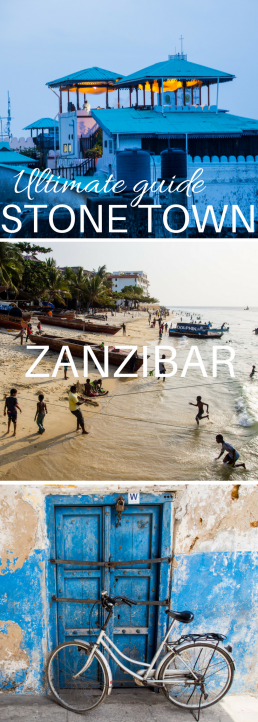
Picking Berries in Central Park, Helsinki
The Central Park in Helsinki is far away from a manicured garden, though it starts right at the center of the city, Töölönlahti Bay. This 10 square kilometers recreational park is a real forest where animals like foxes, hares, badgers, weasels and raccoon dogs roam freely.
For city-dwellers like us, the Central Park offers primal nature at our doorstep. During the weekends the park is teeming with bicycles, joggers and dog walkers. Horseback riding routes pierce the forest along with several cross-country skiing tracks during the wintertime.
Pick Berries, Mushrooms and Other Finnish Superfoods
While strolling in the middle of lyric Nordic forest, you are free to pick berries, mushrooms, wild herbs, or anything else nature has on offer. Last spring I collected nettles, goutweed, lady’s mantle and other wild herbs less than a kilometer from our apartment, which is pretty centrally located in Helsinki. During the summer and autumn we picked wild strawberries, raspberries and bilberries (wild blueberries) with our little dog, Trece. She loved to munch billberries straight from the bush and we got billberry pie for the dessert.
Wander Around the Pet Cemetery of Maunula
We love to cross the park with our beloved dog to visit a tiny pet cemetery inside the park limits in the area called Maunula. That’s where our old German shepherd mix Misha has found his last resting place among around 3000 dogs, cats, hamsters, hedgehogs and other departed darlings. You can also try to find the “presidential” gravestone belonging to the dog of Juho Kusti Paasikivi, the president of Finland during the 40s and 50s.
We just love the serene atmosphere at the pet cemetery year-round. At Christmas time people bring candles for their loved ones, a tradition that is well nurtured in Finland. During summer the graves have flowers, photos, and toys of departed family members.
We will continue to share with you our secret spots in Helsinki. In the meantime we are anxious to know, if have you ever visited our hometown.
Pin this story!
